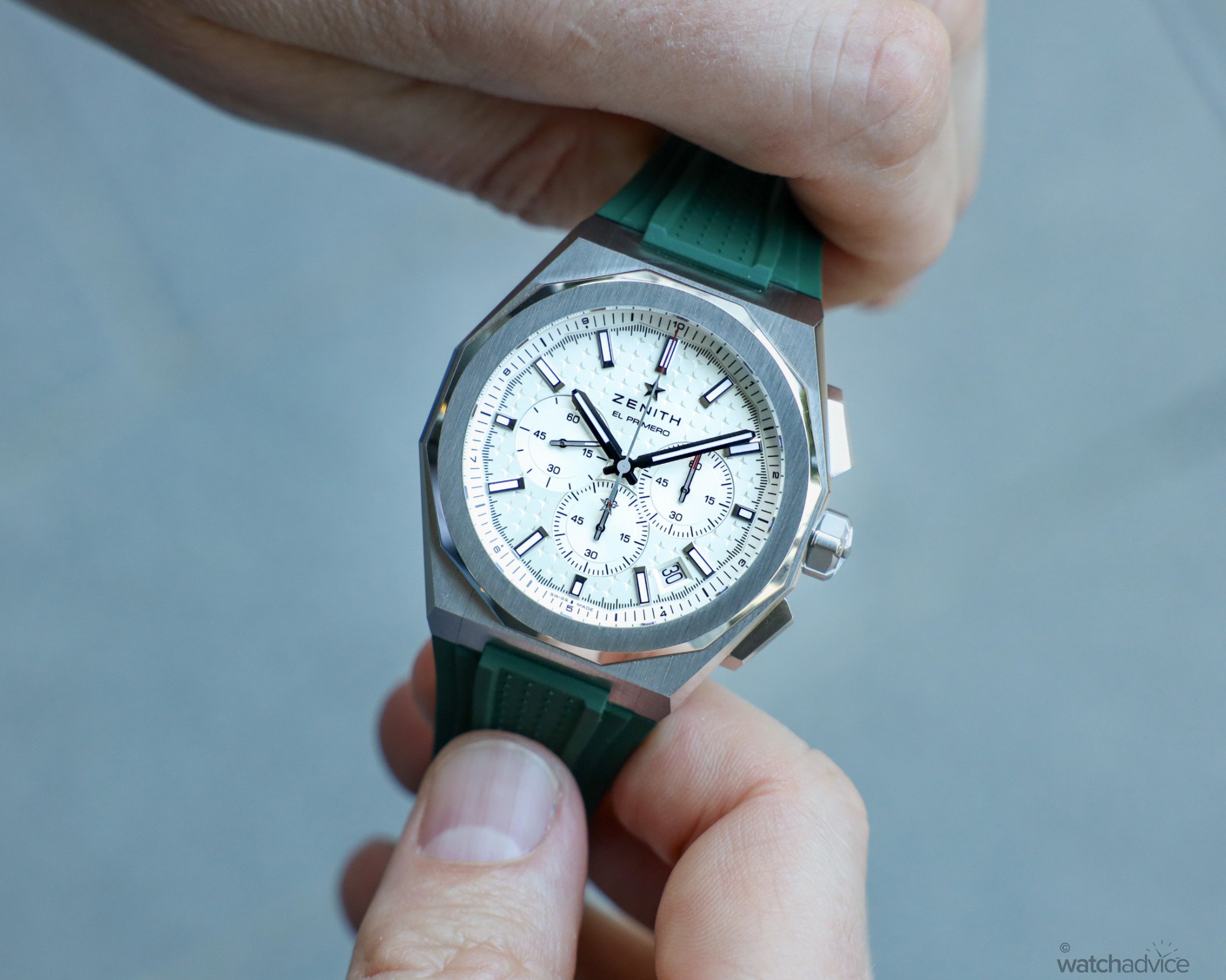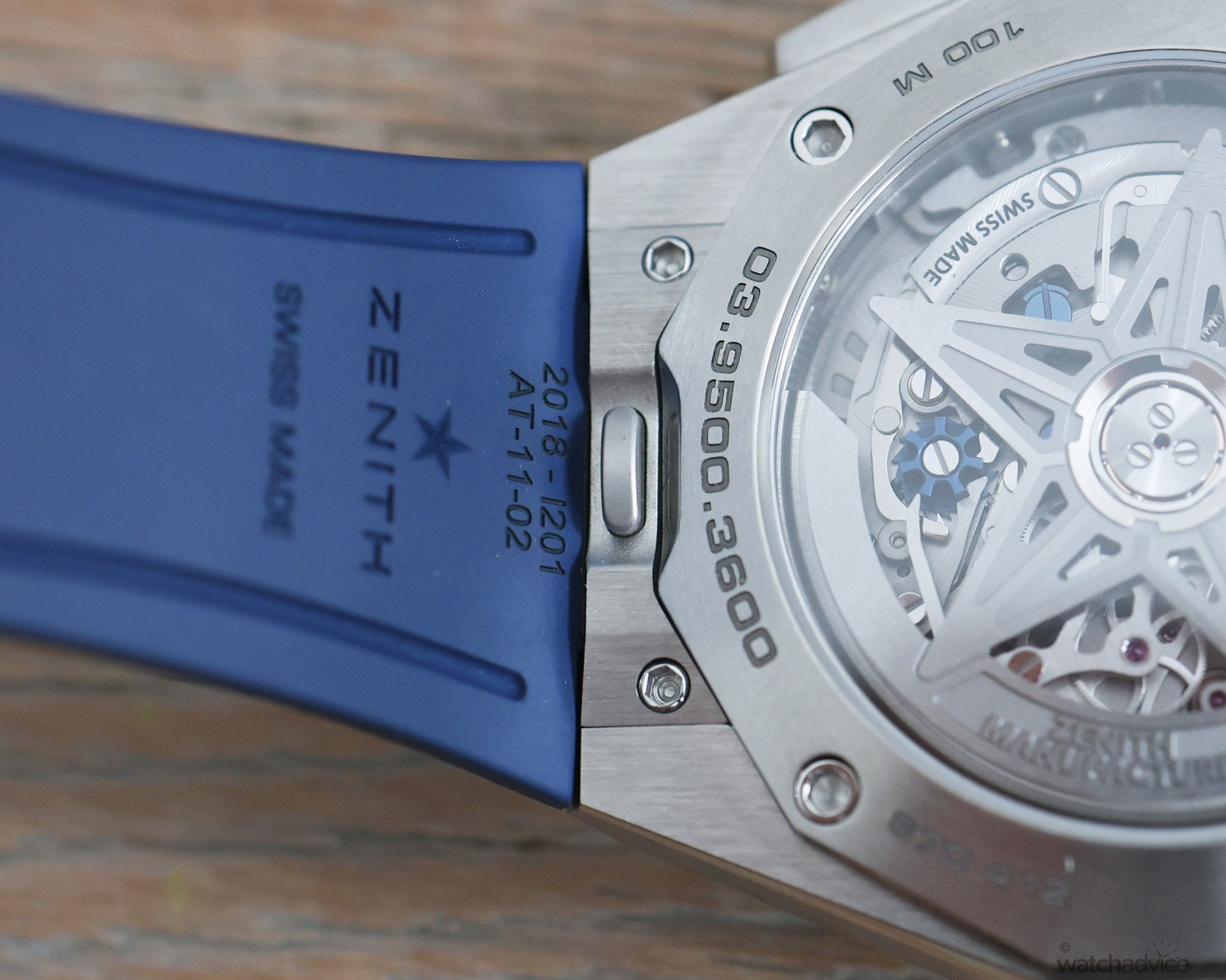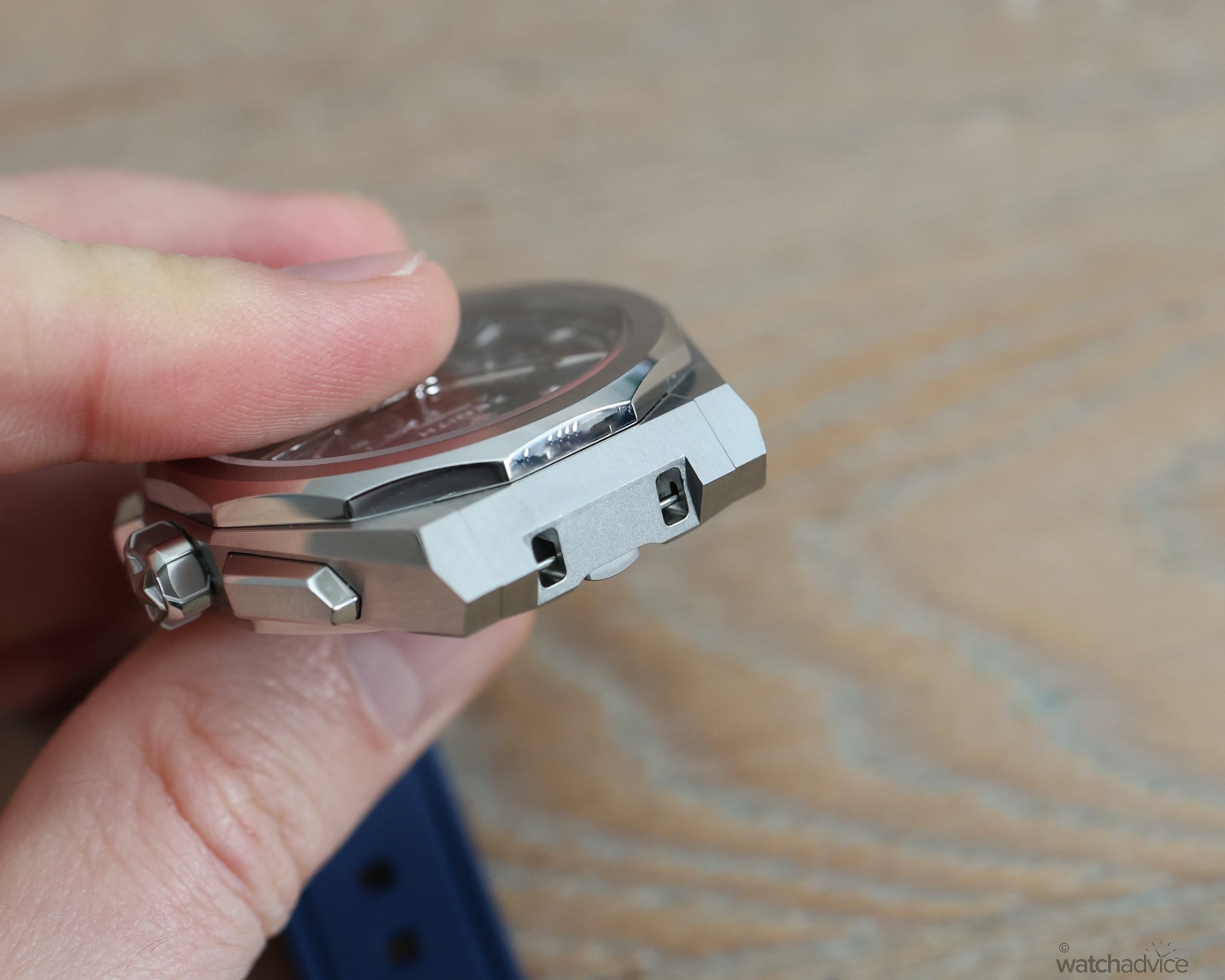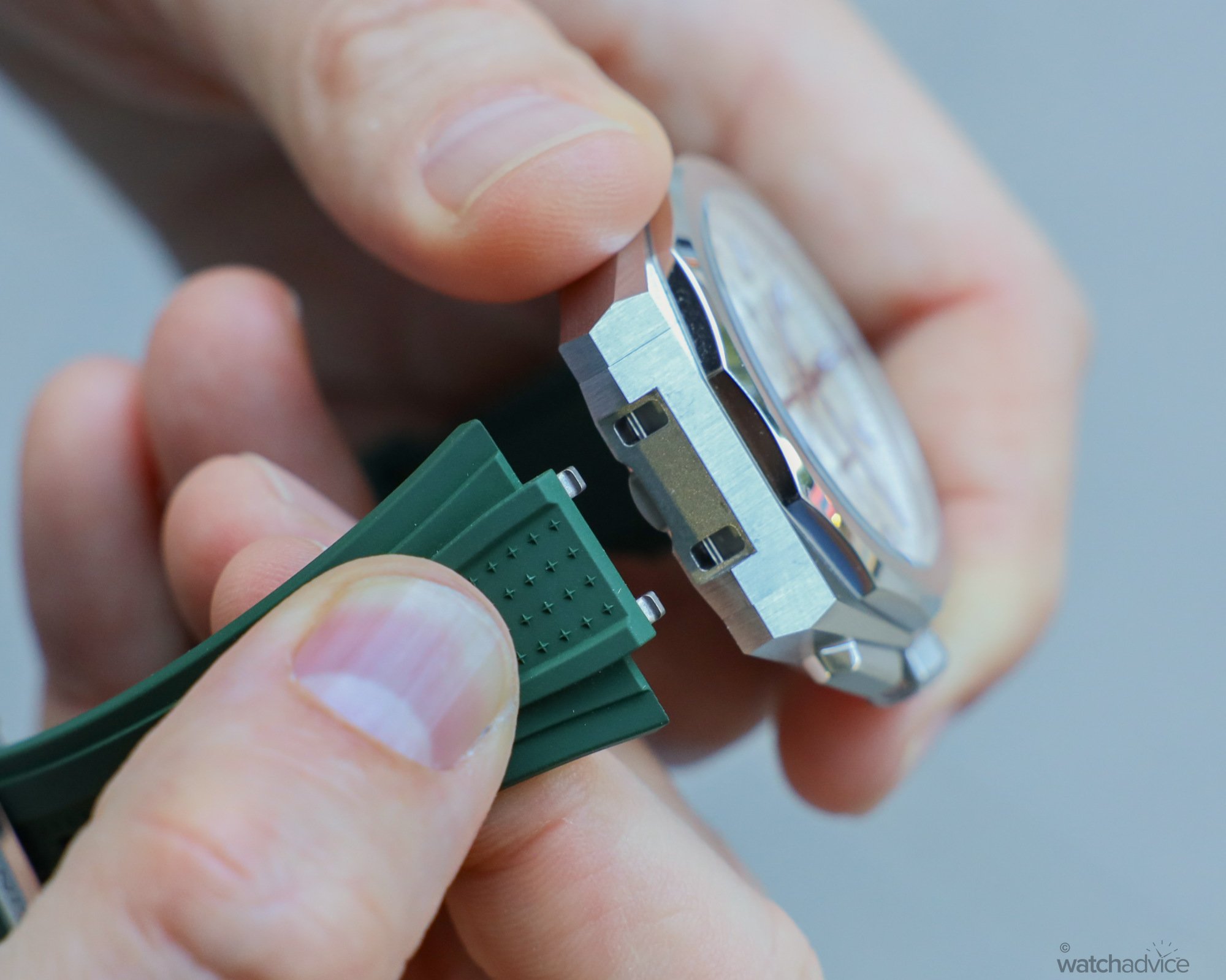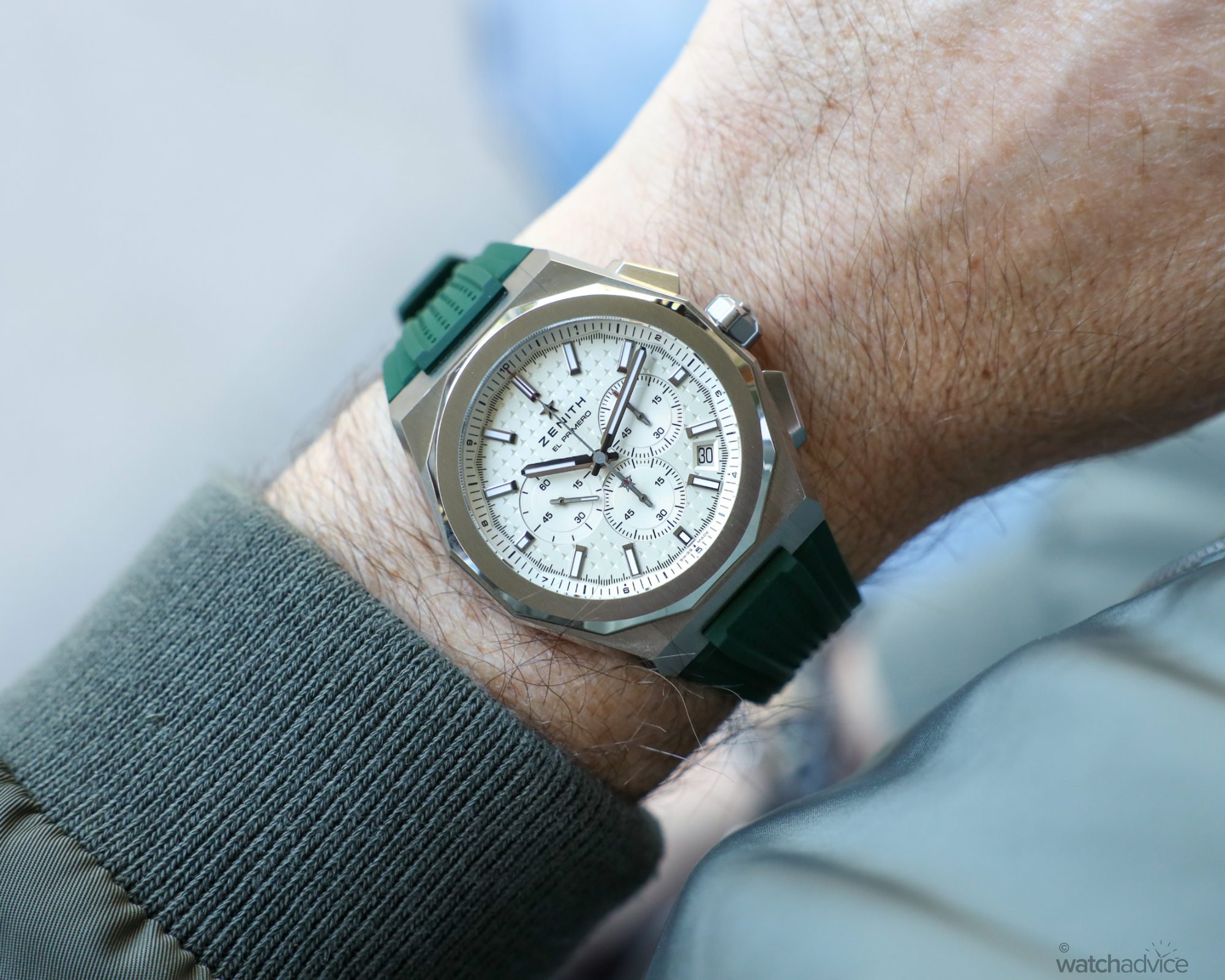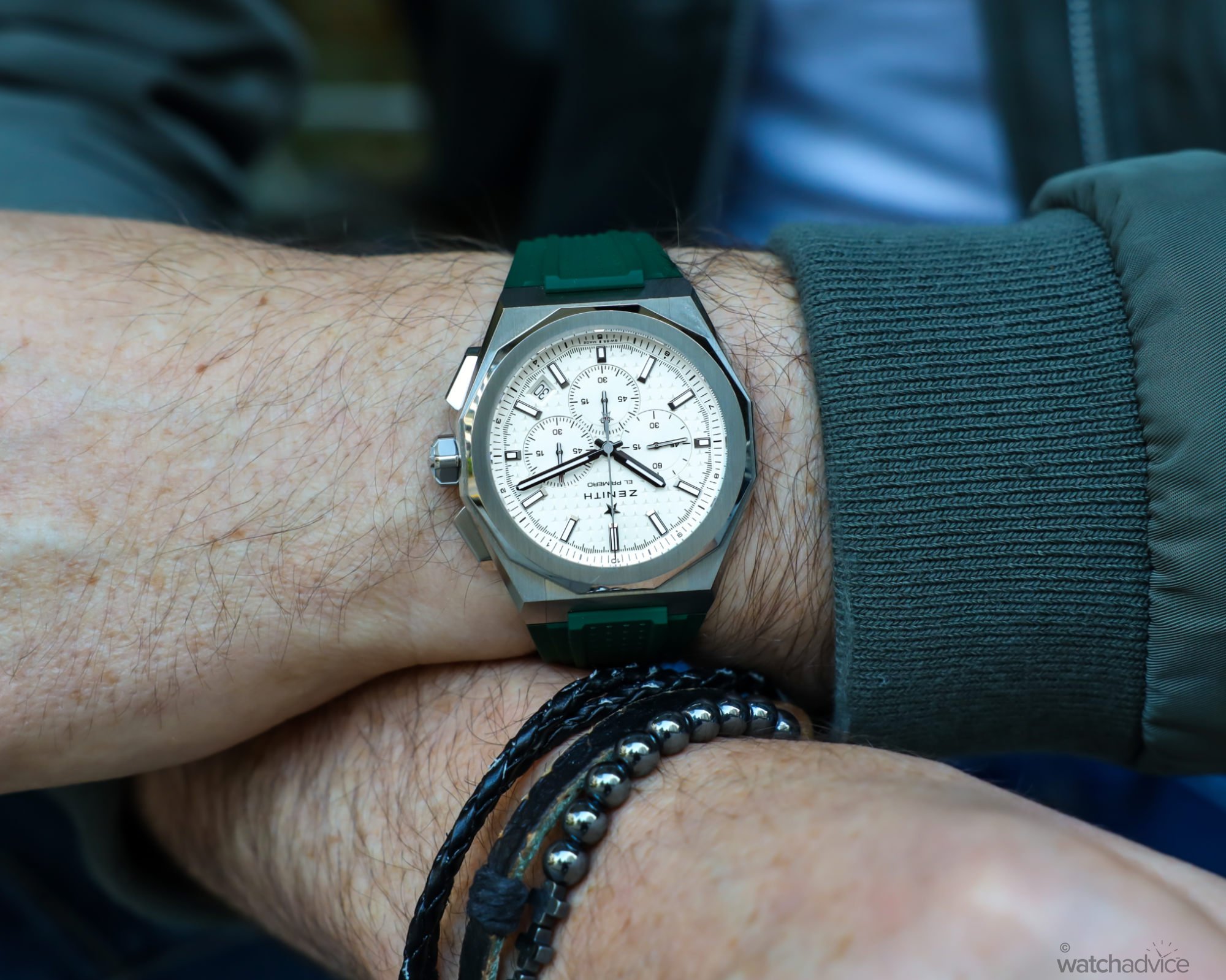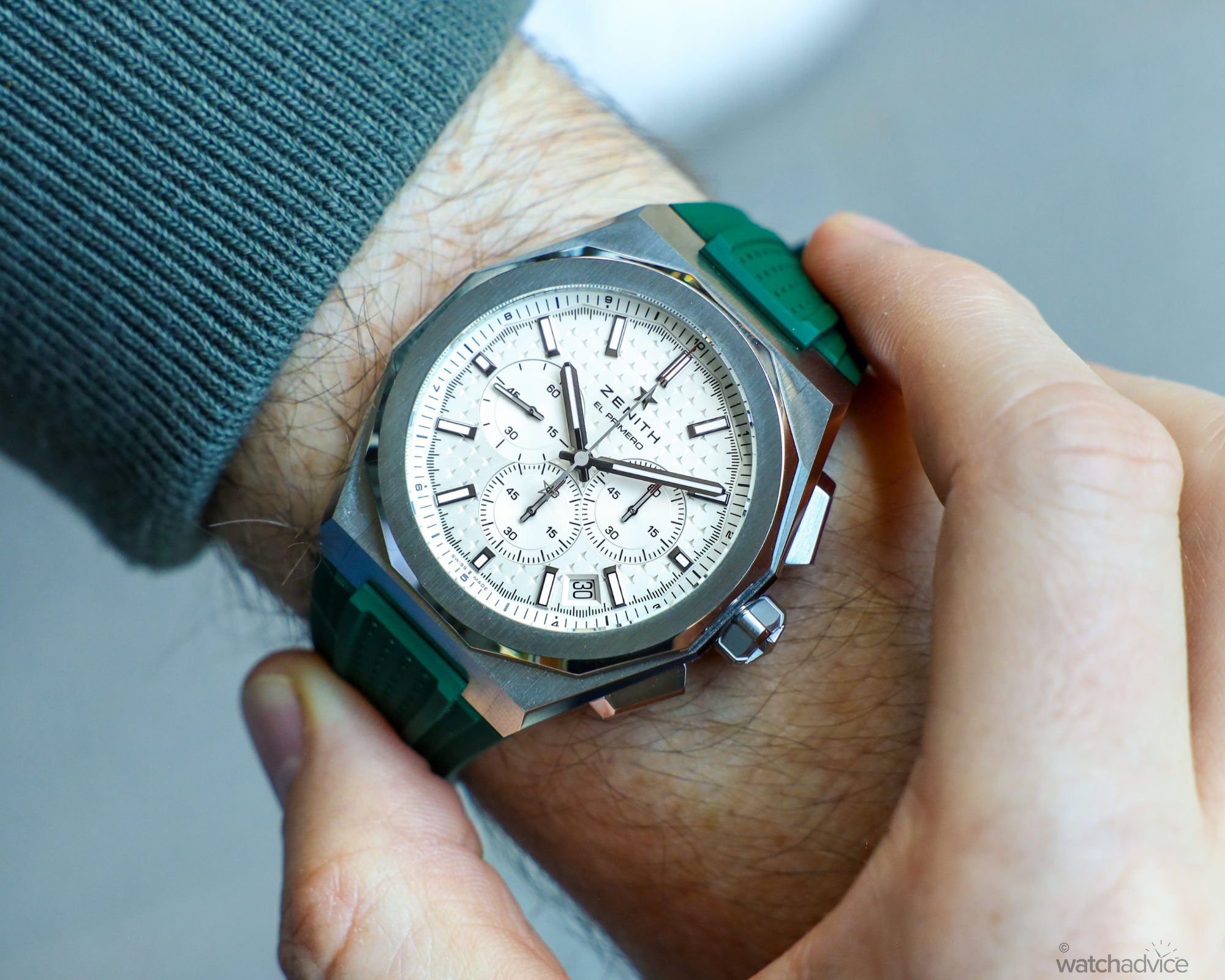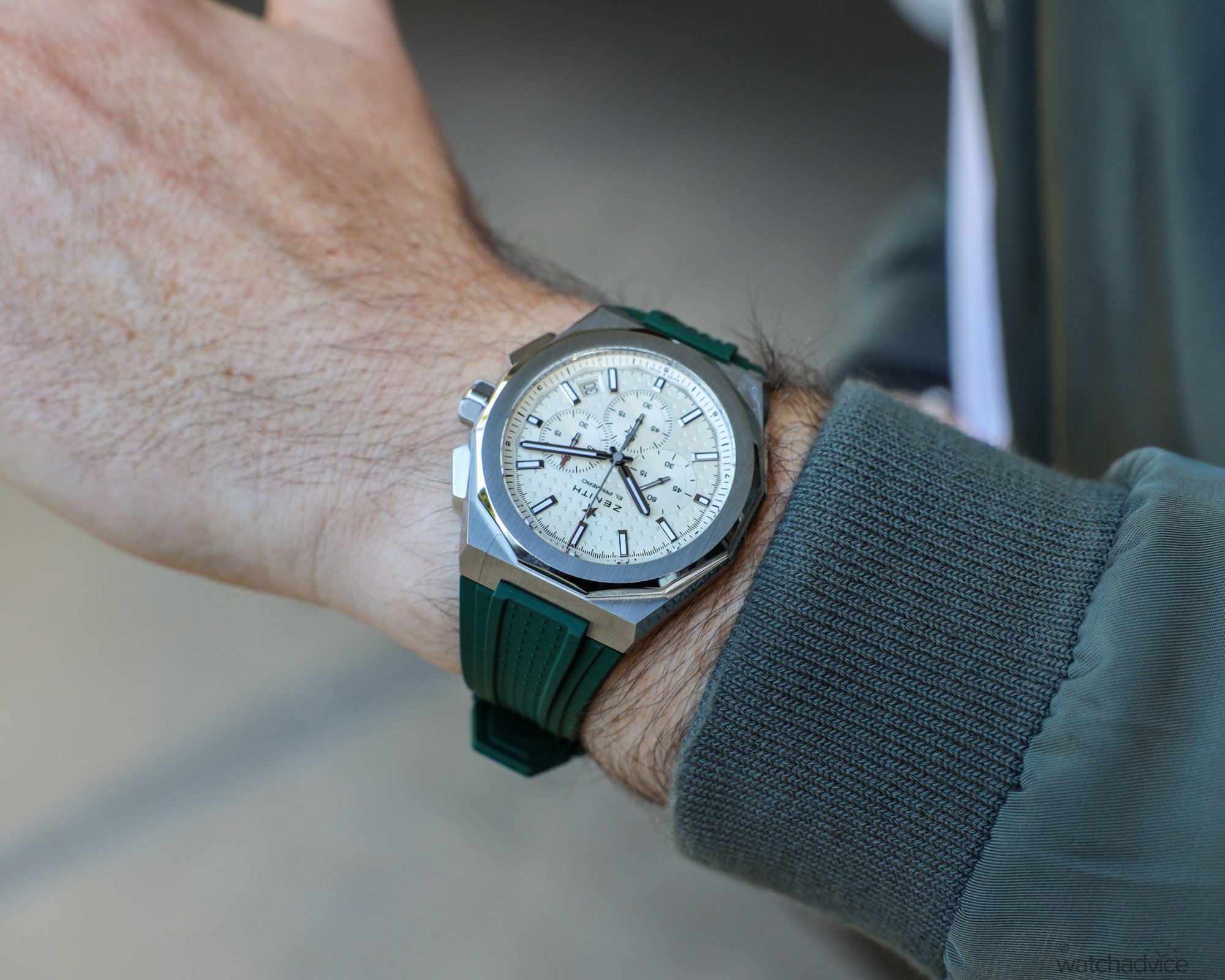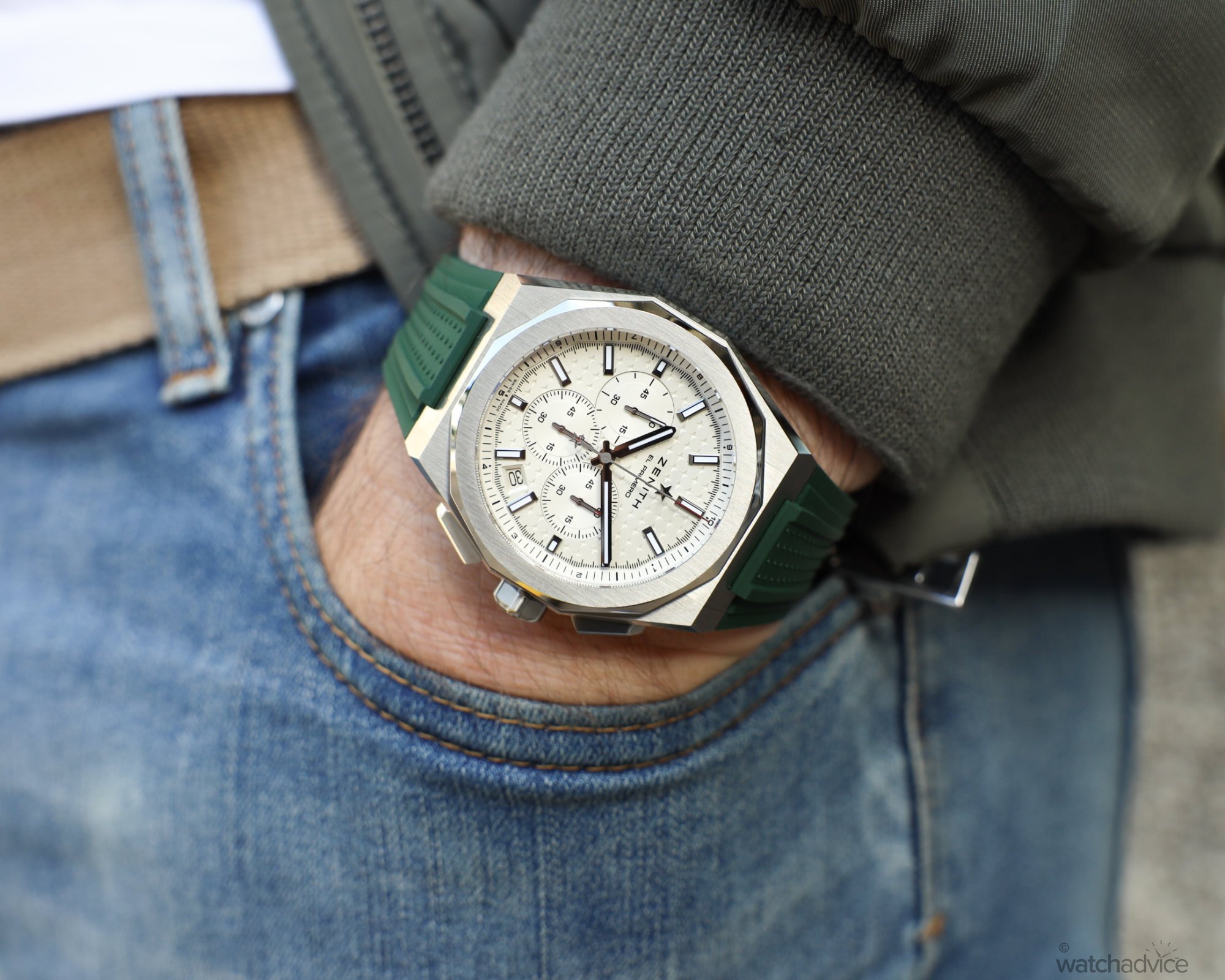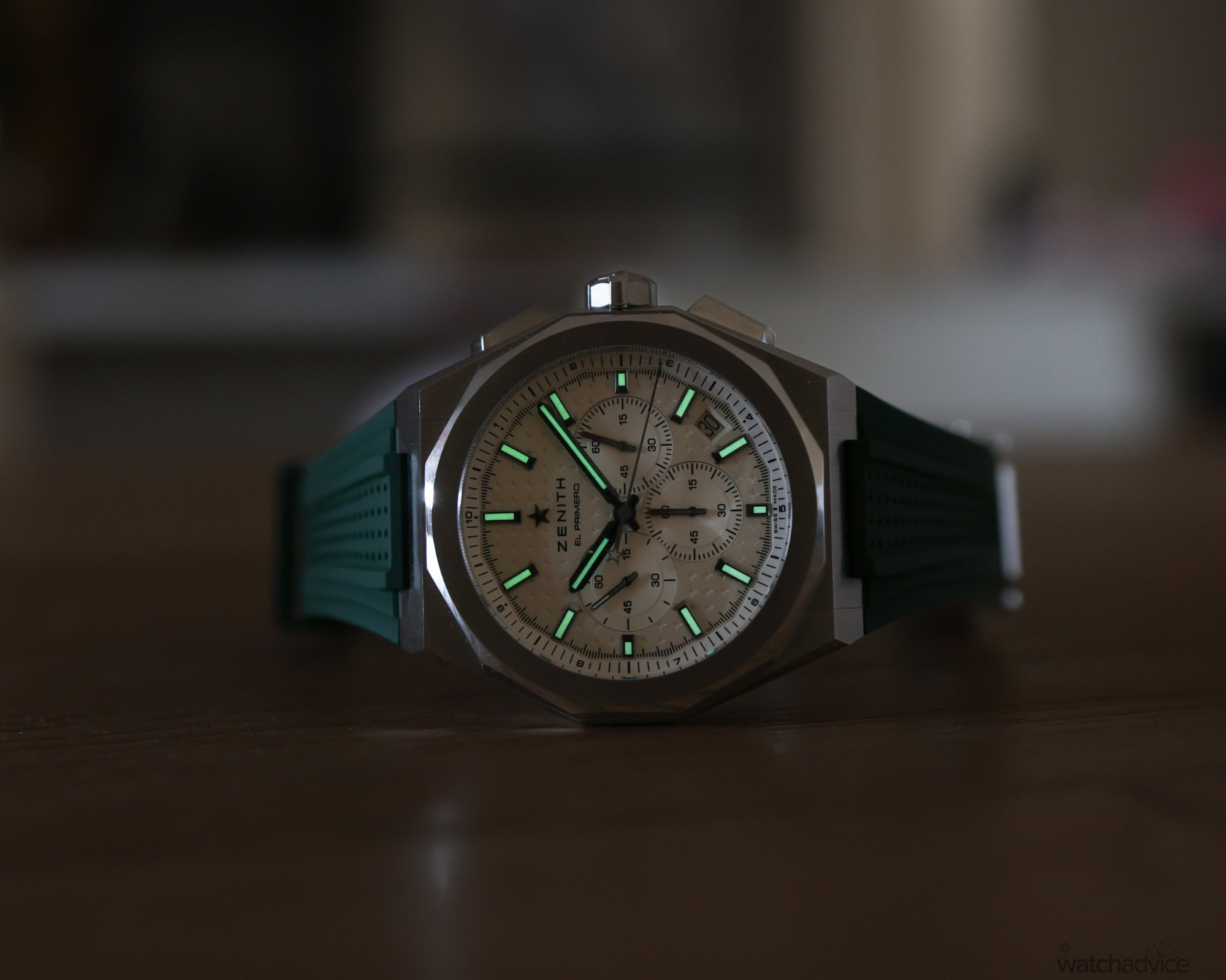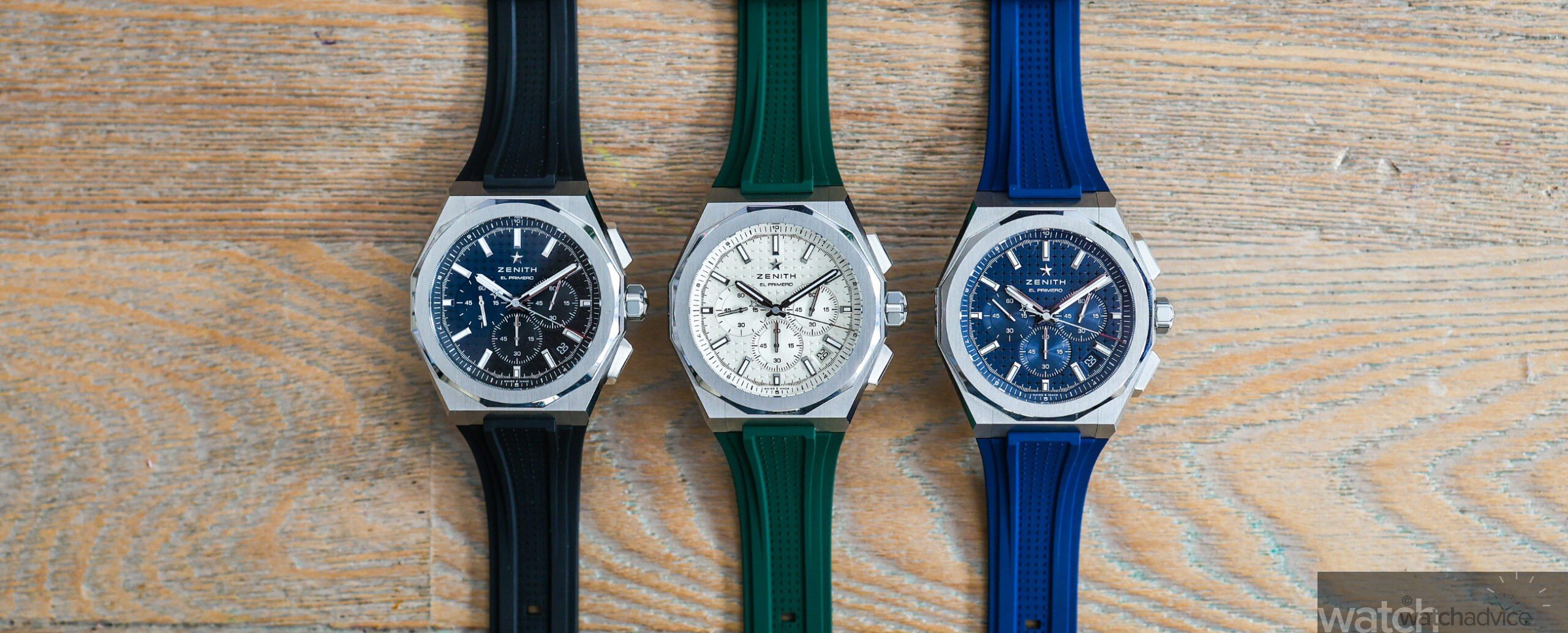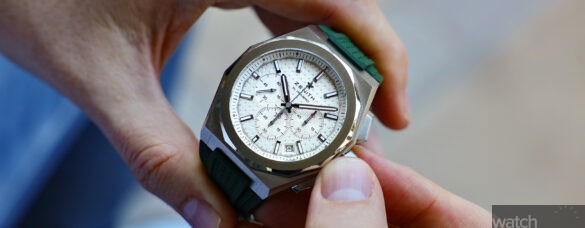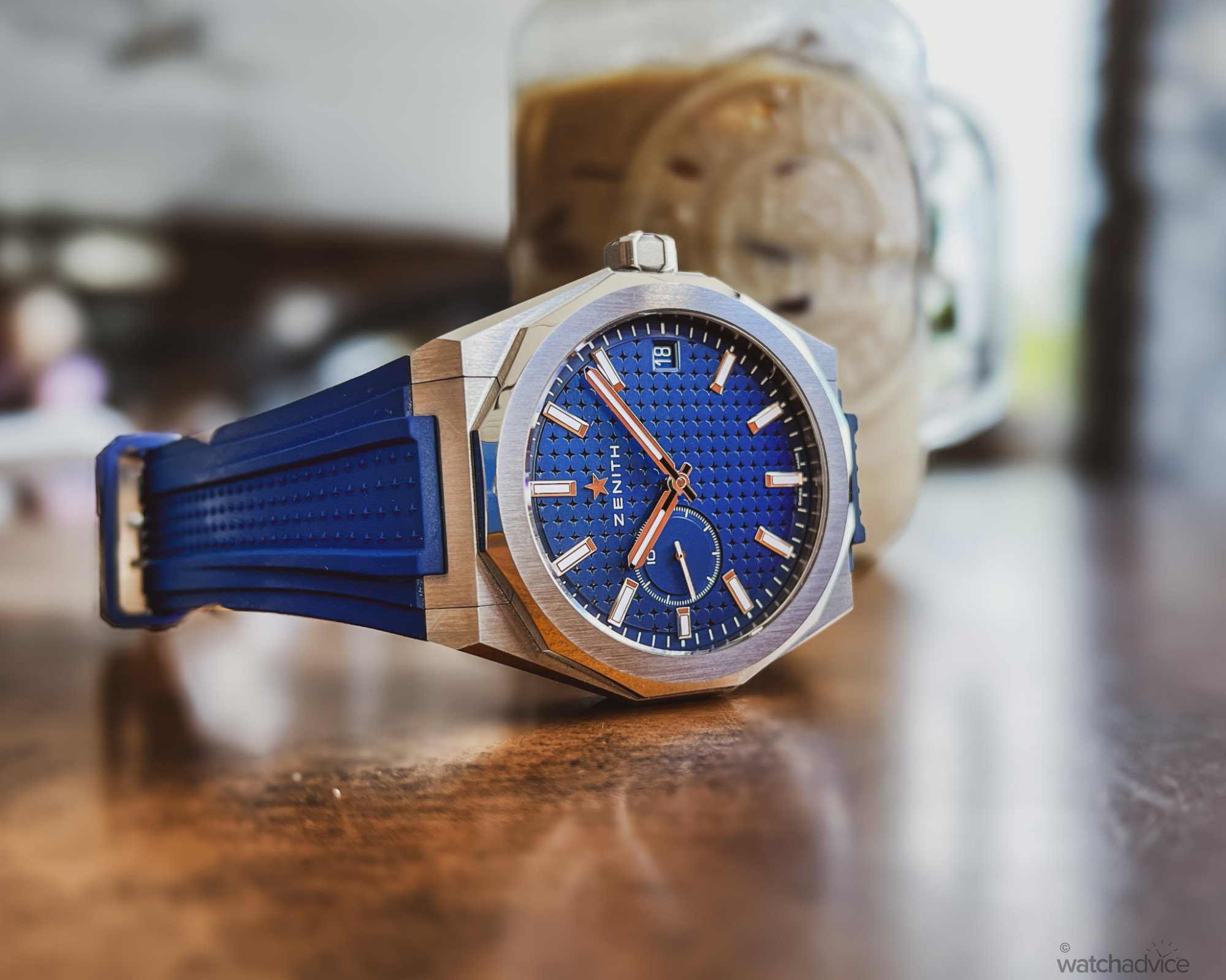IN PARTNERSHIP: Almost 2 months ago at Watches & Wonders, Zenith released a chronograph version of their highly popular Defy Skyline – The Defy Skyline Chronograph and we thought let’s see how they compare to the OG.
What We Love
- The edgy look, true to its DNA
- Quick change strap & bracelet system
- Accuracy of the 1/10th chronograph
What We Don’t
- Clasp can irritate the wrist on the rubber
- Still no micro-adjust for the steel bracelet
- On the larger side and may not be for all wrists
Overall Rating: 8.75/10
- Value for money: 8.5/10
- Wearability: 8.5/10
- Design: 9/10
- Build quality: 9/10
The Zenith Defy Skyline is no stranger to me. In fact, I’m very familiar with both the brand as well as the Defy Skyline having the Blue dial version as part of my collection. So, when I heard that Zenith were adding a chronograph version to the Skyline collection, part of me was curious as to how they’d look and wear, the other part was really looking forward to seeing them in person upon their release. And if I’m honest, part of me was interested in how they would compare to my Defy Skyline, which if you’re interested in comparing this review to my Owners’ Perspective, feel free to read it here.
Initial Impressions
Our first experience with the new Defy Skyline Chronograph was a brief one – amidst the chaos that is Watches & Wonders and at the Touch and Feel Session with the full range of Zenith’s launches this year. However brief the experience was with this particular watch, it was enough to know these were a great addition to the collection. We were also fortunate enough to meet and talk to Sébastien Gobert, Zenith’s Creative Director whilst there and he explained the goal of the new pieces was to keep the DNA that makes the Defy Skyline what it is and enhance it with the 1/10th second chronograph without losing the look and feel of the original as well as the proportions as much as possible. Based on our first look and playing around with it, I’d say they’ve done that.
Fast forward a couple of months, and getting all three to review now meant we could give them a decent amount of wrist time to see how they would stand up in normal day-to-day life. My first impressions this time around? The white dial (although, Zenith calls this silver) on the green strap was the one I’d road-test. The dial drew me in and funnily enough, I didn’t gravitate to the white dial when purchasing mine, but now with the additional chronograph features, it looked the business, especially on the green rubber strap.
The Design
As mentioned, the team at Zenith has kept the design of the Defy Skyline Chronograph true to its predecessor. It’s Defy through and through and Zenith, Sébastien and the team have done a good job of keeping the case shape and aesthetics consistent with the non-chronograph version, adding in only what was needed for the chronograph functions. You still have the angular 8-sided case design that screams Zenith, as is the 12-sided fixed bezel that is vertically brushed on top and polished on the side.
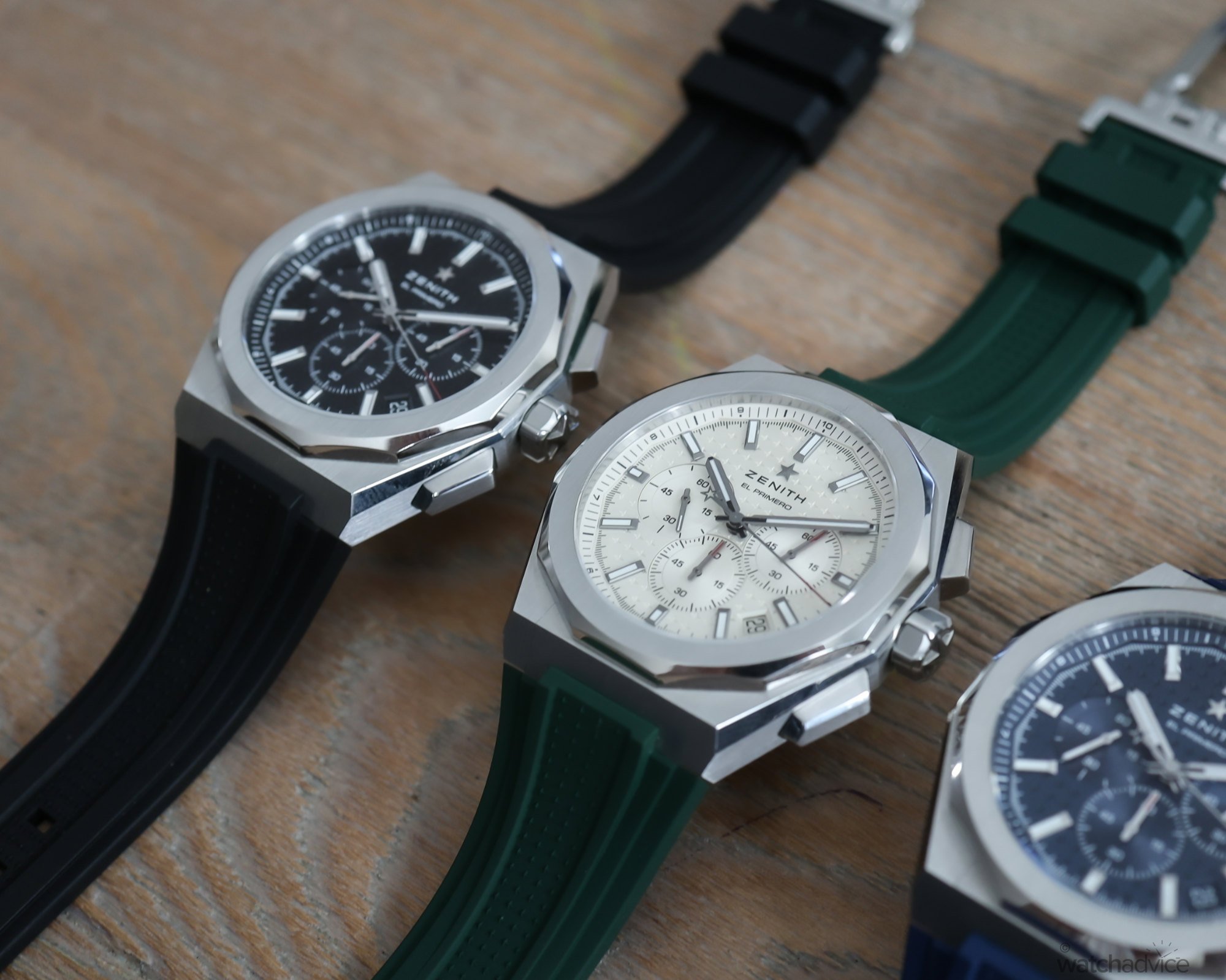
The dial is where the Defy Skyline comes to life, and the white dial, which in this instance was my preference looked absolutely stunning in both low and bright light thanks to the anti-reflective crystal, and the fact that White usually doesn’t reflect the light so your viewing experience of the watch is a lot better than what would be with a dark dial. The combination of the white dial and the green rubber strap just works, especially for those more casual occasions, and the concentric circular subdials break up the star pattern on the dial nicely.
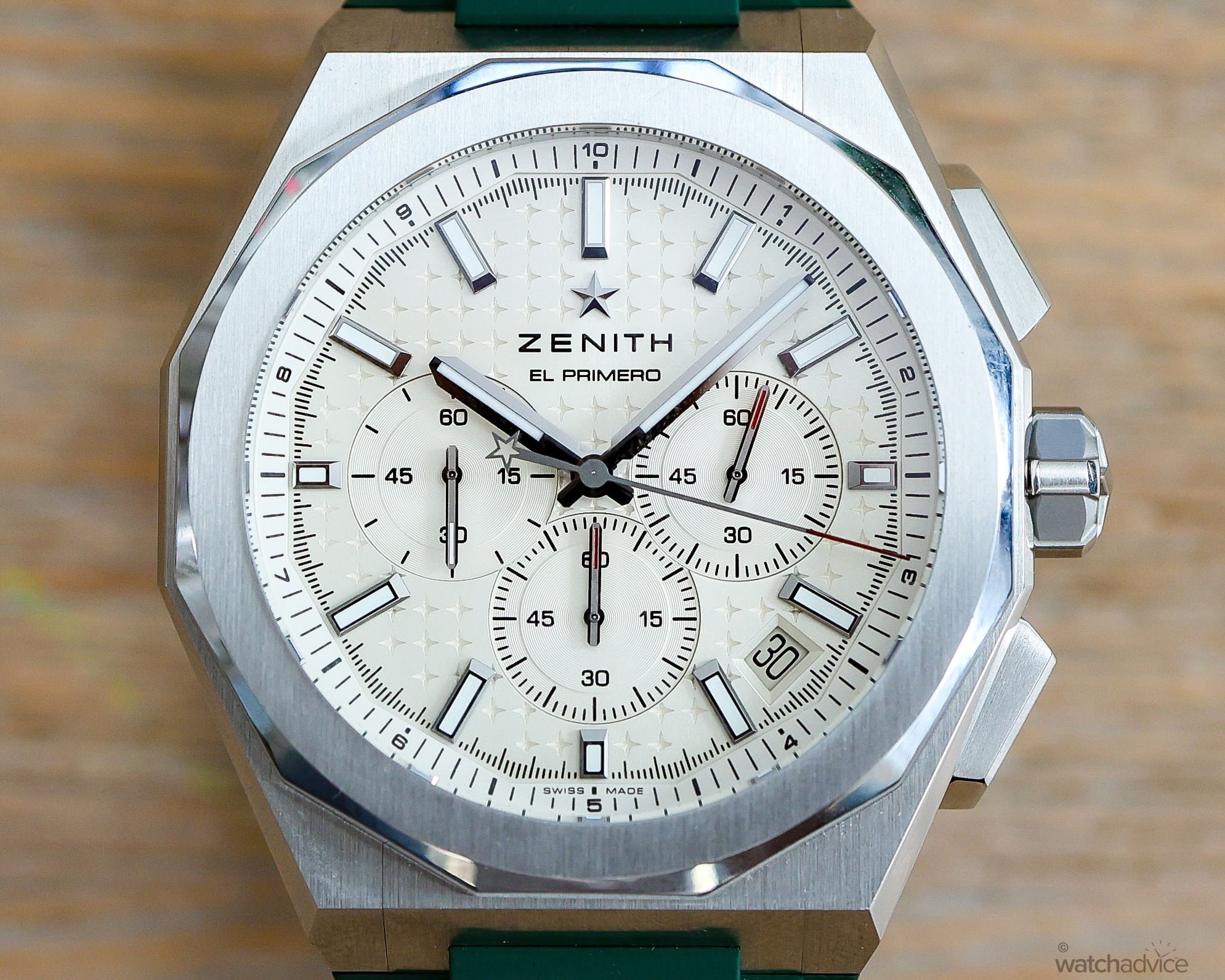
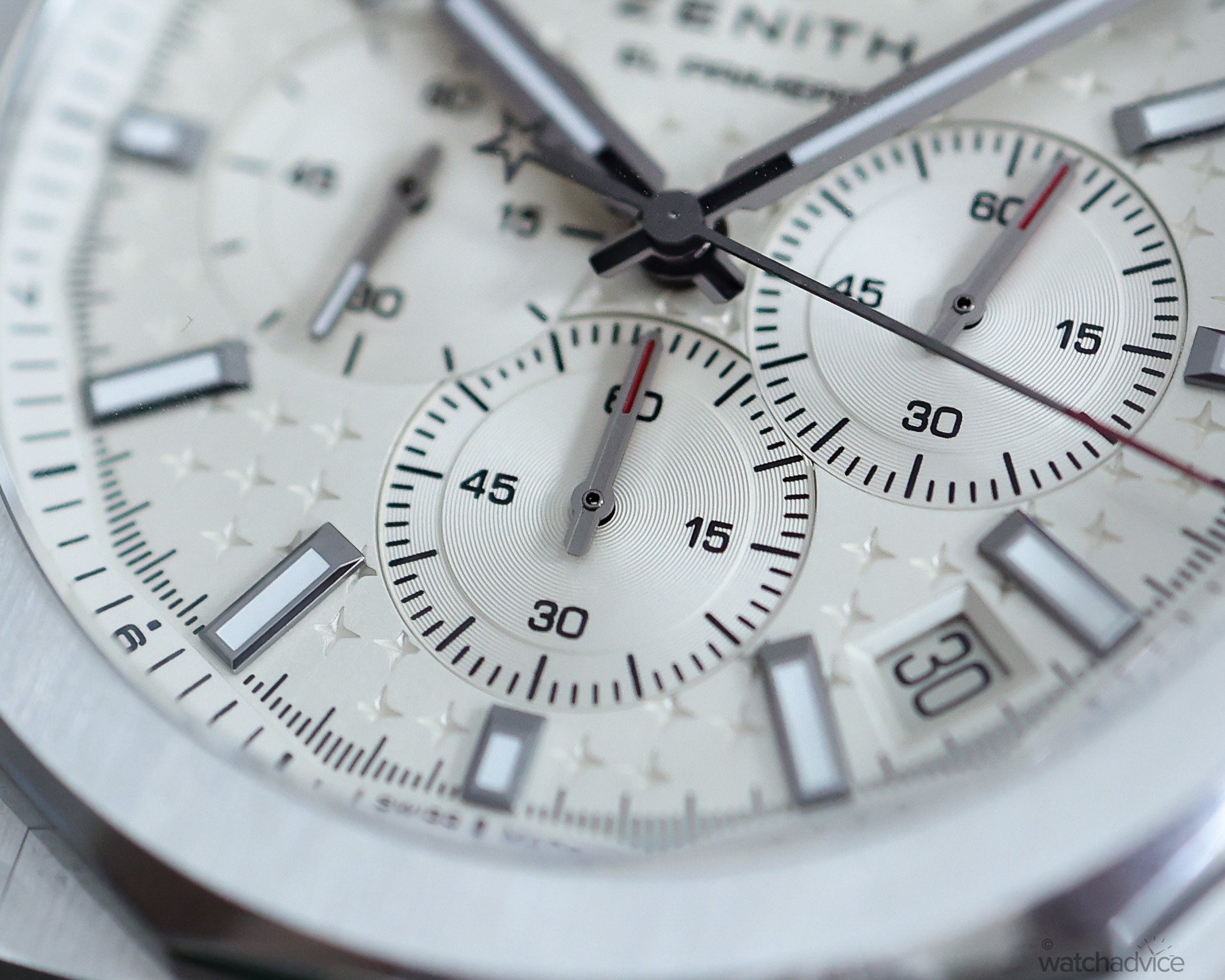
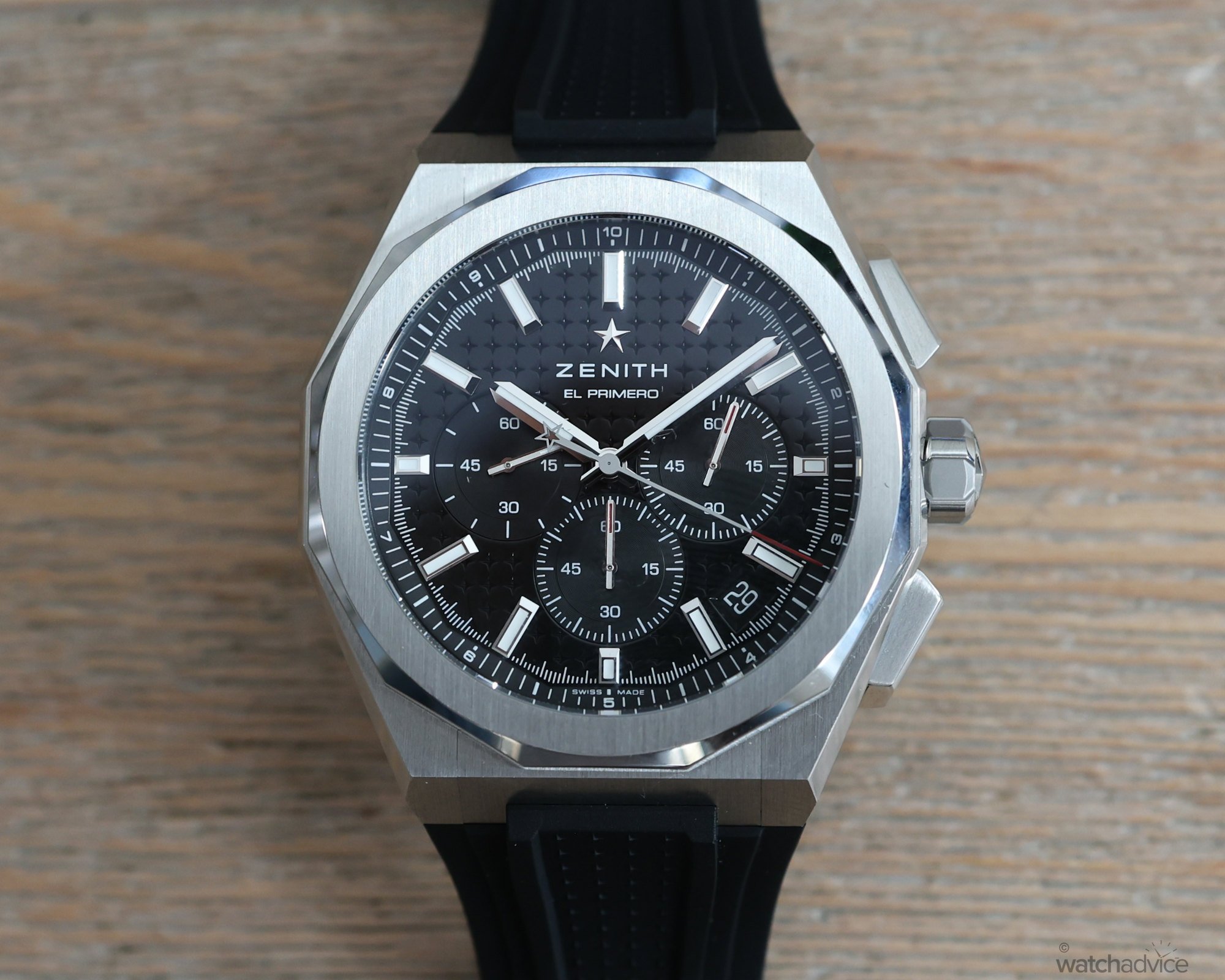
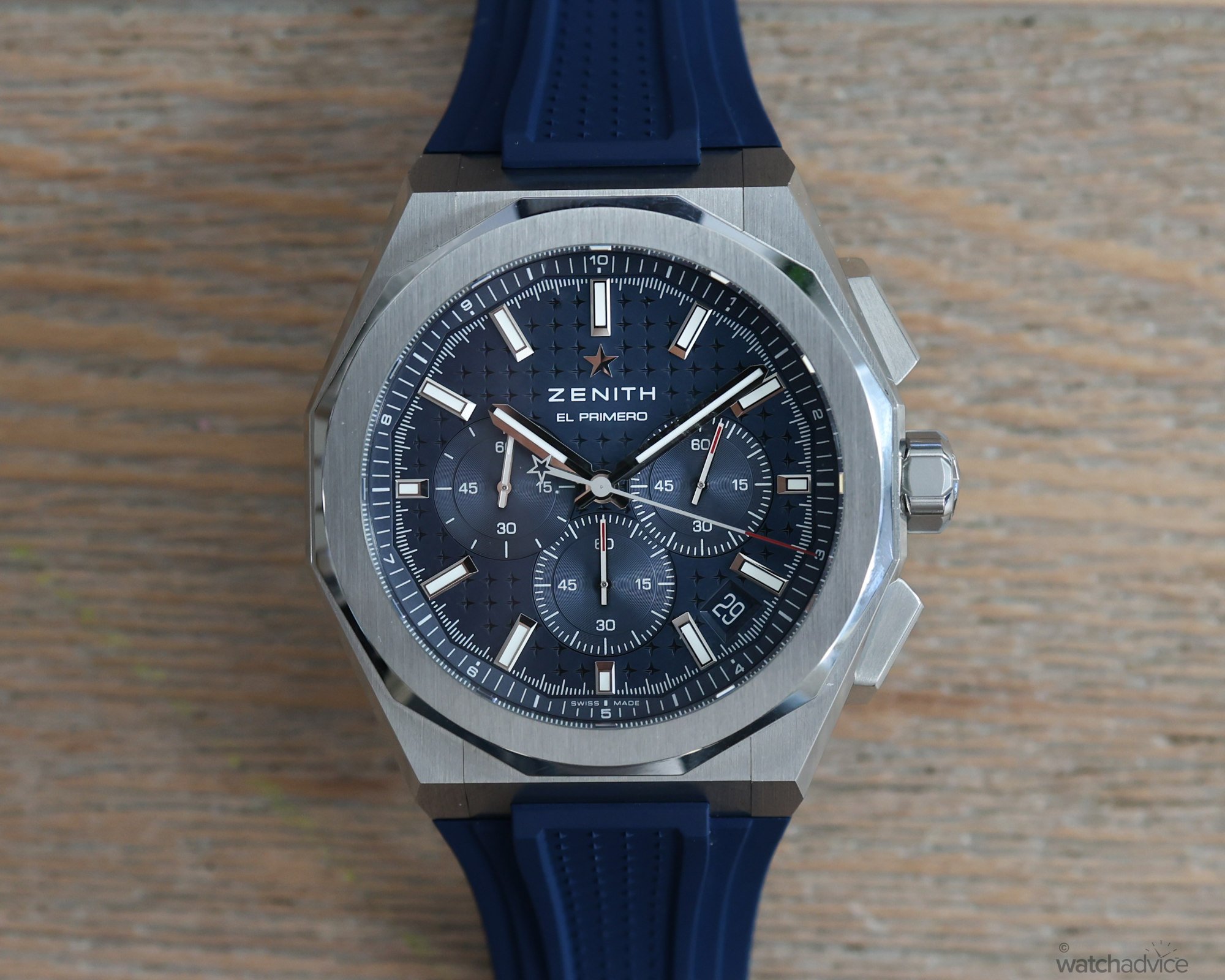
As comes standard with the Defy Skyline range, is Zenith’s quick-change system, which comes in handy when swapping from the rubber strap to the steel bracelet. For me, this is where you get great value for money on these pieces as you can change the look of them quite easily and the quick change mechanism is fairly seamless and literally takes about 30 seconds to do yourself without the need of any tools. This is something that I have always said that a lot of brands need to start doing these days – at least offering two options in a combination of leather or rubber and steel. As you can see from the images below, it’s easy to swap in and out the straps by pushing the button and releasing the strap.
How It Wears
The nice thing about the new Zenith Defy Skyline is the size and design have changed very little from the time/date version, meaning that if you’re a fan of the original, you’ll like this too on the wrist. The only real major difference is the slight increase in size. The Defy Skyline Chronograph is now 1mm larger than the original, moving from 41mm to 42mm to accommodate the chronograph movement and subdials. The pushers on the side add a little more to the size from a visual perspective when on the wrist as does the fact that integrated bracelet and strap-designed watches normally wear slightly larger than the measurements would indicate.
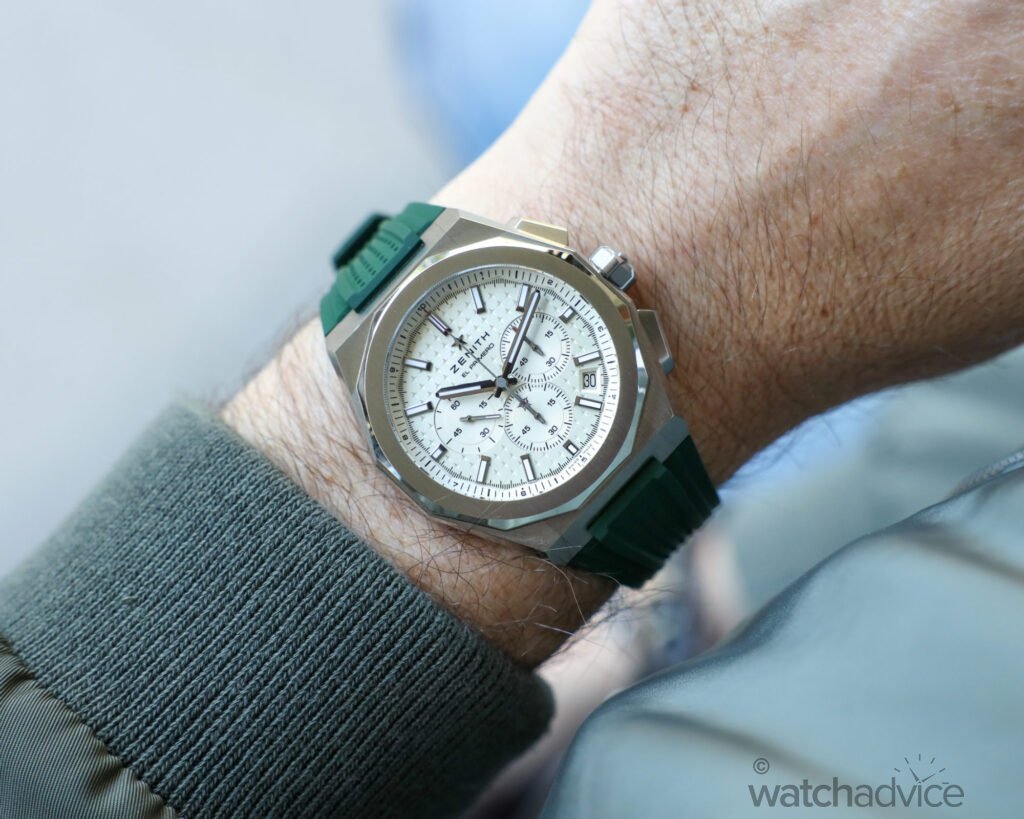
However in saying this, on my 17.5cm wrist, (slightly smaller in the cooler months) the piece still wears fairly true to form, especially on the rubber strap. If you prefer a smaller watch if you have slimmer wrists, then you may want to put it on to get a sense for it first. But, I will say this. The great thing about the silver/white dial is, it draws your eye into it meaning that you’re not looking at the case so much, and on the wrist, the perception of size isn’t skewed as much as a less vibrant dial would when you have a completely contrasting colour to the case. The white somehow creates the illusion, paradoxically, this is true to size. The rubber strap also helps to create a slimness to the look, and with Zenith Defy Skyline straps and bracelets, they taper quite a bit, which adds an overall balance to the watch.
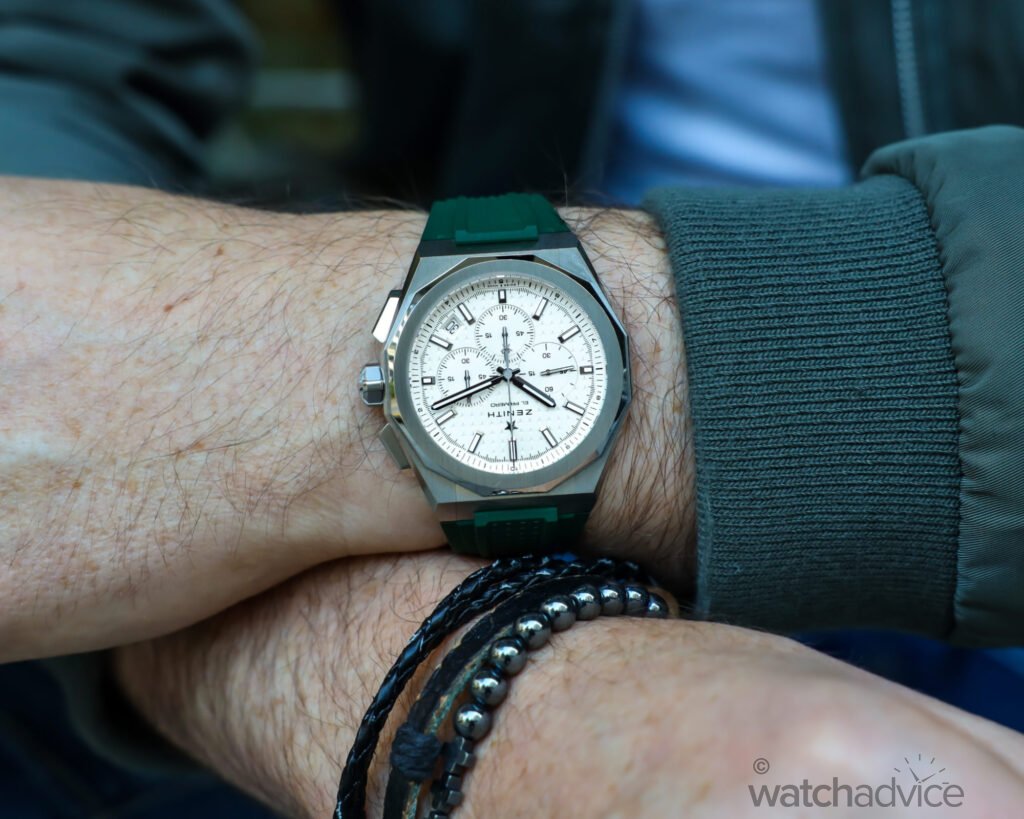
As you can see from the image above, and caption, the watch sits squarely in the middle of my wrist and with little to no lugs, the strap effectively clips into the case. This means you’ve not got any issue with a longer lug-to-lug as you can with other integrated bracelet and strap watches. You commonly hear that Audemars Piguet Royal Oaks, or Girard-Perregaux Laureato’s wear a couple of millimetres larger due to this fact, and from experience with these pieces, they do. As an example, the 38mm AP royal Oak Chronograph wears more like a 40/41mm thanks to this. With the Zenith, it’s not so much an issue here.
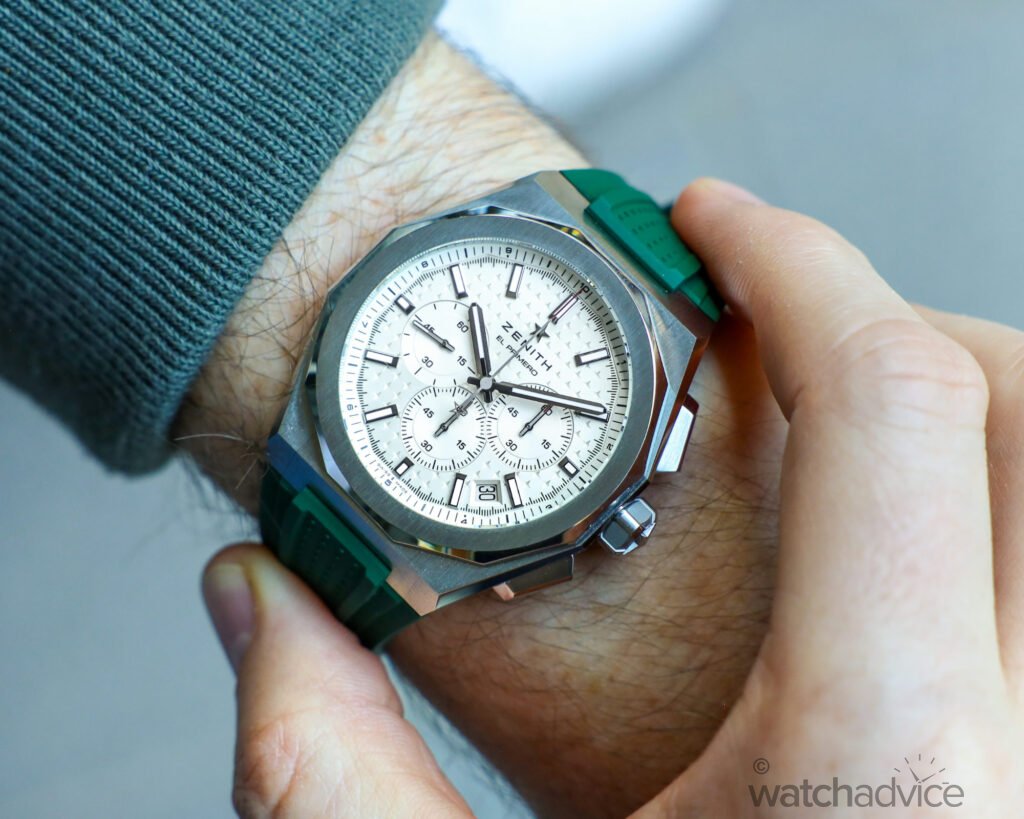
The balance of the watch is pretty good too. The rubber strap hugs the wrist nicely and doesn’t allow the watch to move around too much if worn snugly, which is what I would recommend with this piece. Some watches when worn more fitted can be uncomfortable, but the way Zenith designs their straps means they’re soft, conform to the wrist well and aren’t an issue to get the right fit. On the bracelet, this is obviously harder as you can’t just adjust the pin buckle, but need to remove links. A personal gripe I have with integrated steel bracelets in general with a wrist like mine that fluctuates in size – they’re never quite right. I’d be all over a watch from a brand that has some sort of micro-adjust with its integrated bracelets. I’m just waiting for this to happen and become mainstream!
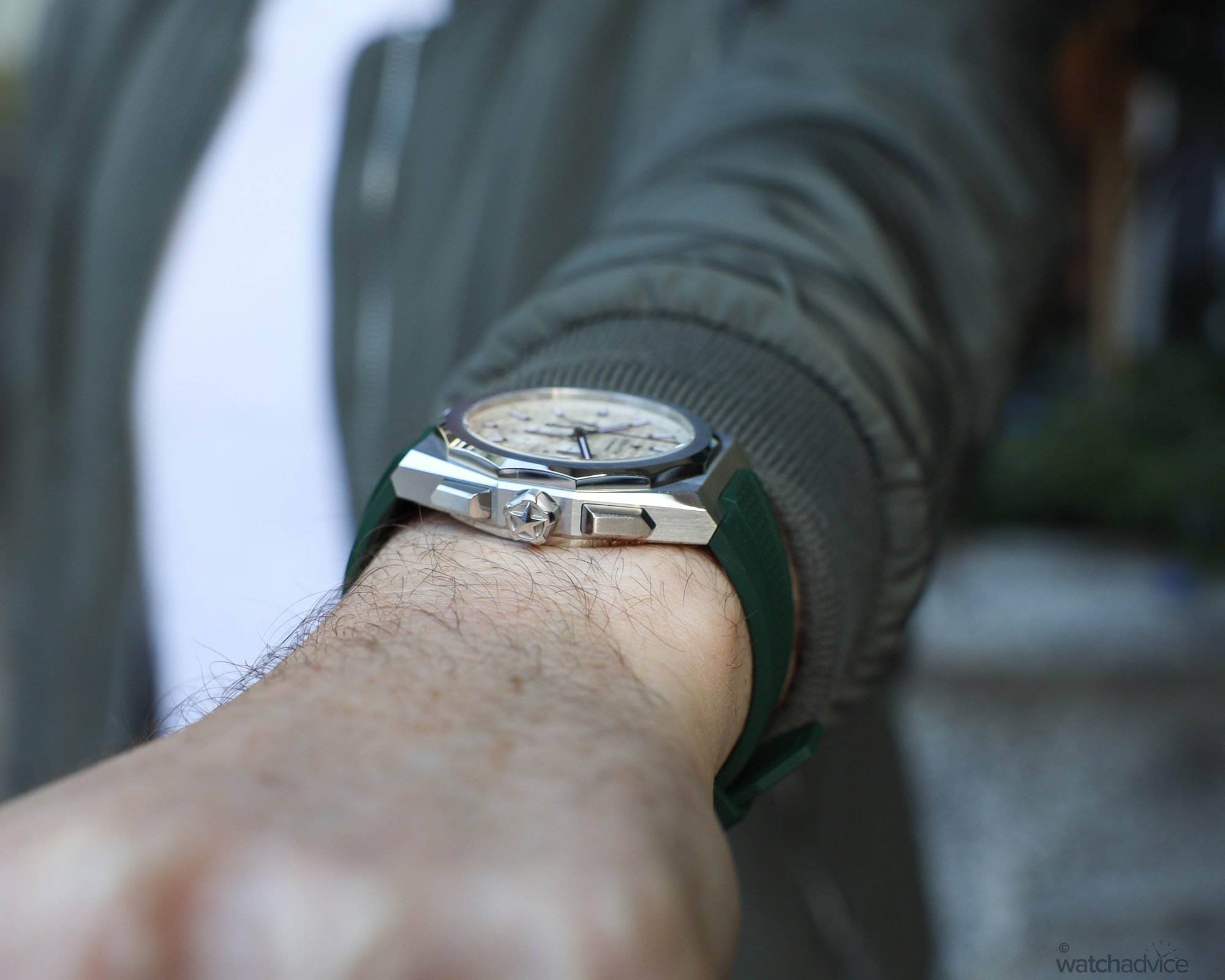
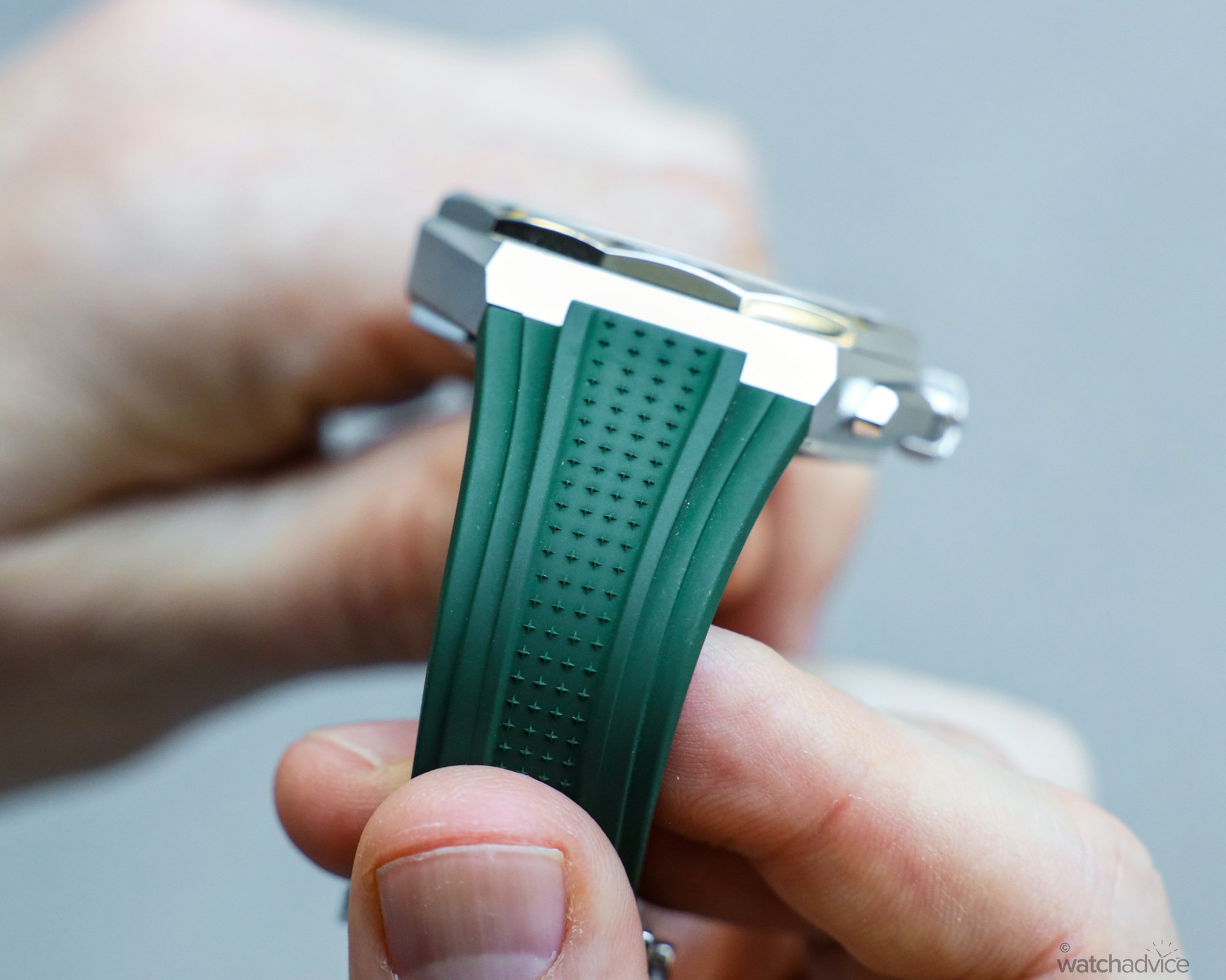
There is one small niggle that I still have with the Defy Skyline strap – the butterfly folding clasp. On my wrist, it still does irritate it a little. Not enough that I needed to take it off, but I did find myself adjusting its position on my wrist every now and then. Now this is a personal thing and comes down to your wrist size and shape and how the piece sits on the individual wrist. I’ve worn pieces that are completely fine on me, but other team members have this issue due to their wrist size and shape. So it’s really a personal thing and one reason we always say to try on the watch first, get a feel for it, and think about how it wears overall.
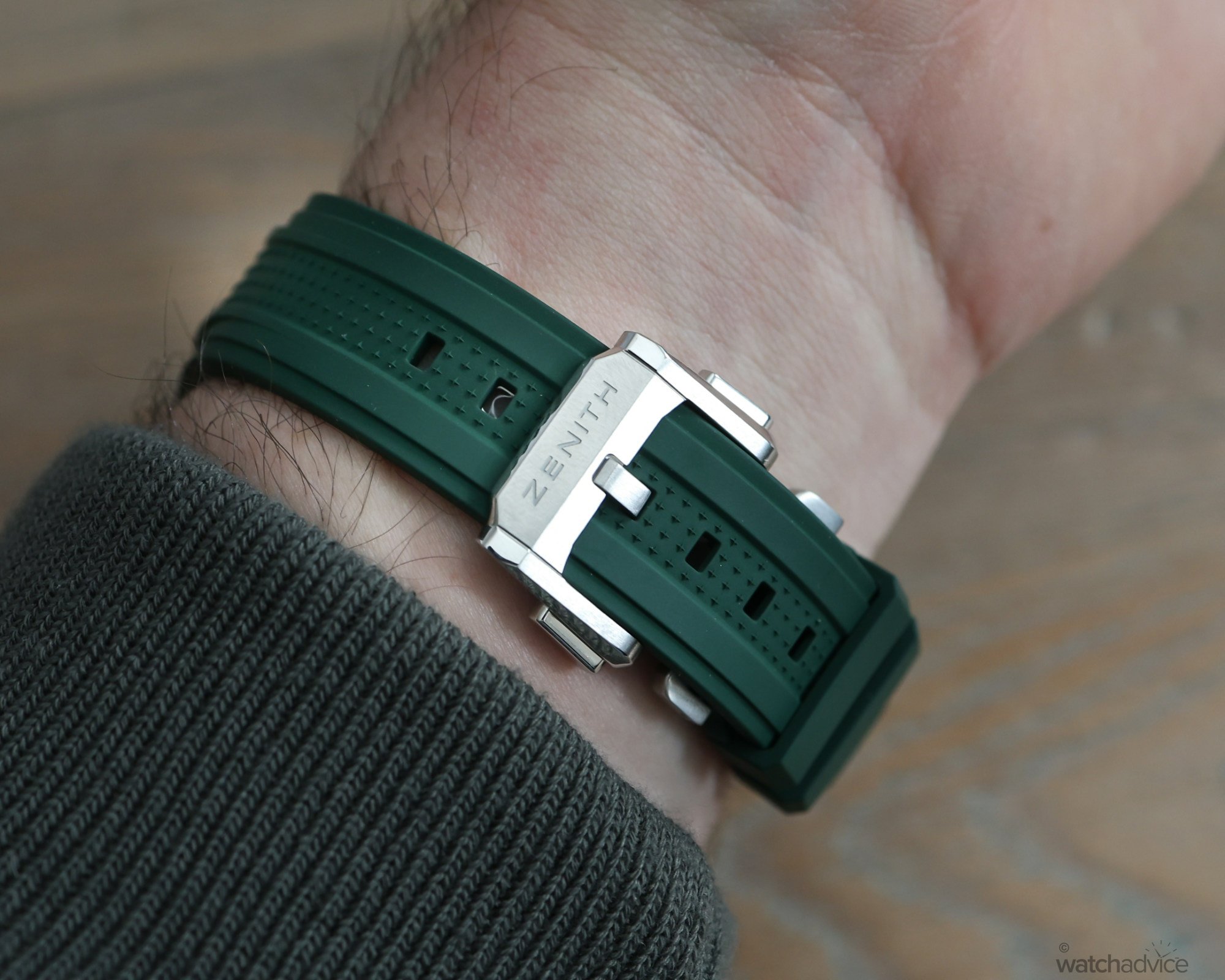
The other aspect I want to mention is the lume. Technically this has nothing to do with how it is worn and feels on the wrist, it does impact time telling in low light. The green-coloured Super-LumiNovaTM shines well on the Defy Skyline. Looking at the image below, this is shot during the daytime, after walking outside in the sun for 30 seconds and then coming inside and taking the picture in low light. This with the white/silver dial makes low-light legibility great. However, I have found the lume doesn’t shine as bright for as long as other pieces I have in the collection if you leave it at night for a few hours. Again, this isn’t going to affect a buying decision in any way.
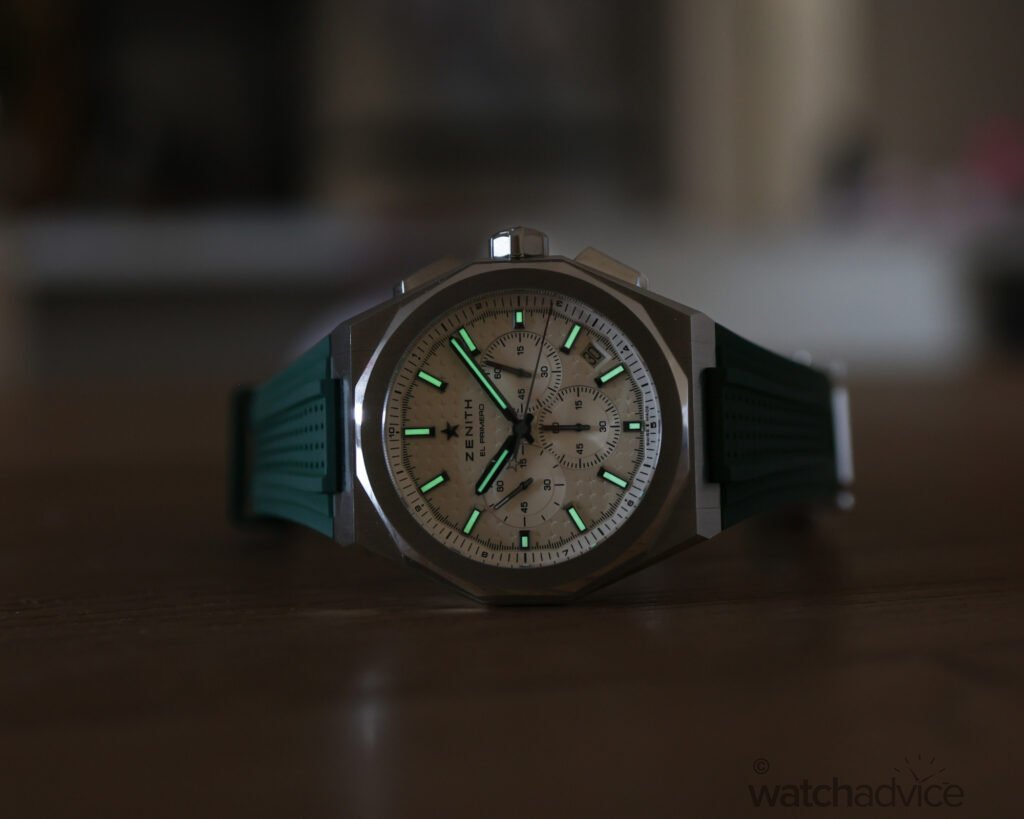
The Movement
Zenith has equipped the Defy Skyline Chronograph with the El Primero 3600 Calibre – its workhorse chronograph movement with 1/10th second timing. Why is 1/10th second important – because every fraction of a second counts! Ok, that was a smart quip, but in reality, most chronographs only give you the hour, minute and second, but with the Zenith, you get the benefit of the seconds and minutes plus the 1/0th second register around the outer dial track. Yes, you don’t get hours, but the reality is, this chronograph is designed to time events that are less than an hour – which when you’re getting down to 1/10th second differences in timing, is most things!
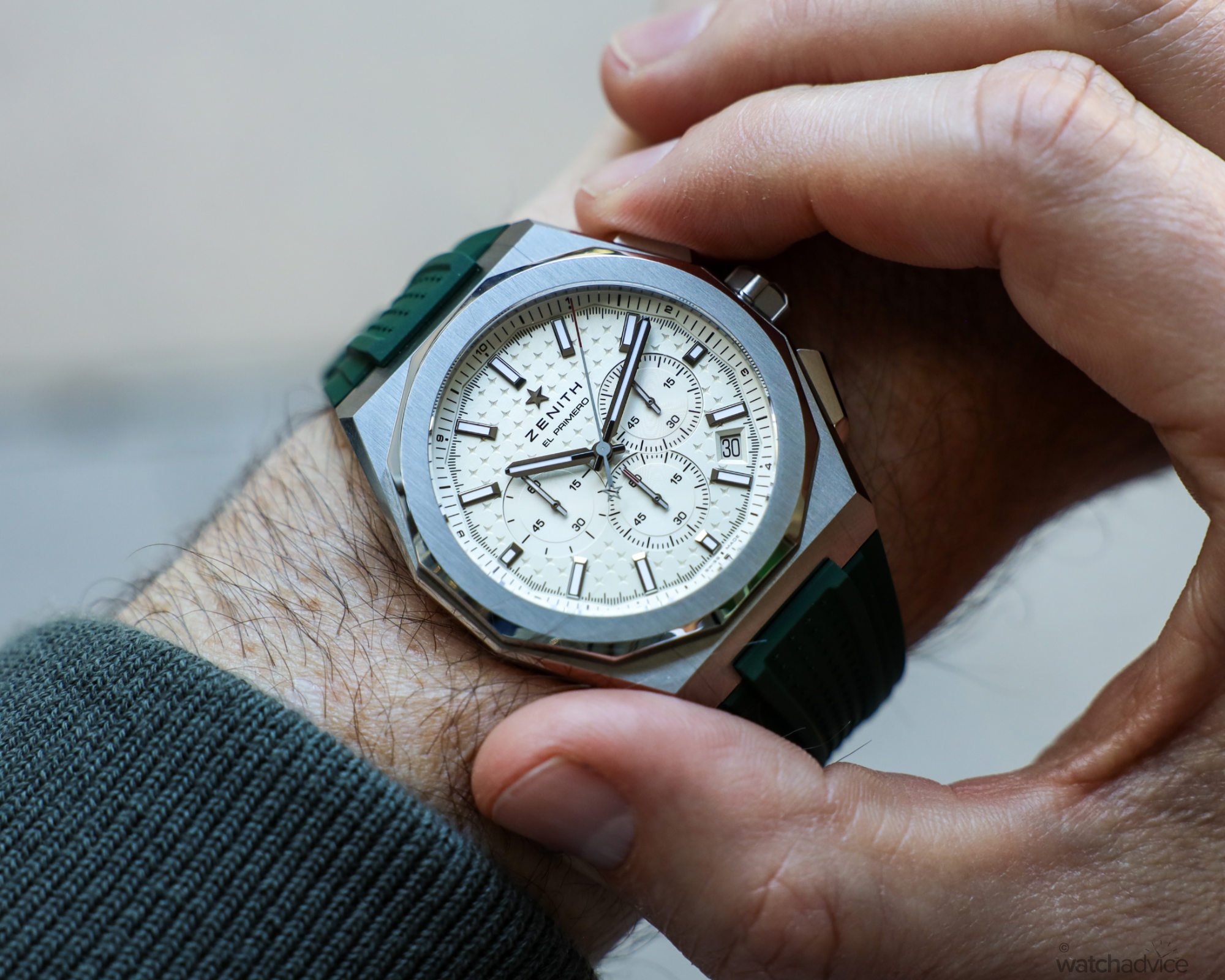
We first saw the El Primero 3600 Calibre back in 2021 when Zenith launched the Chronomaster Sport, a small departure from the 1/100th second timing that you had with the Defy 21 series, like the Defy 21 Ultraviolet. However, this is probably a more useful function in real life, as the 1/100th of a second timing is less functional outside the elite sports arena. The movement is a good-looking movement, however, with the rotor shaped in the form of the Zenith star
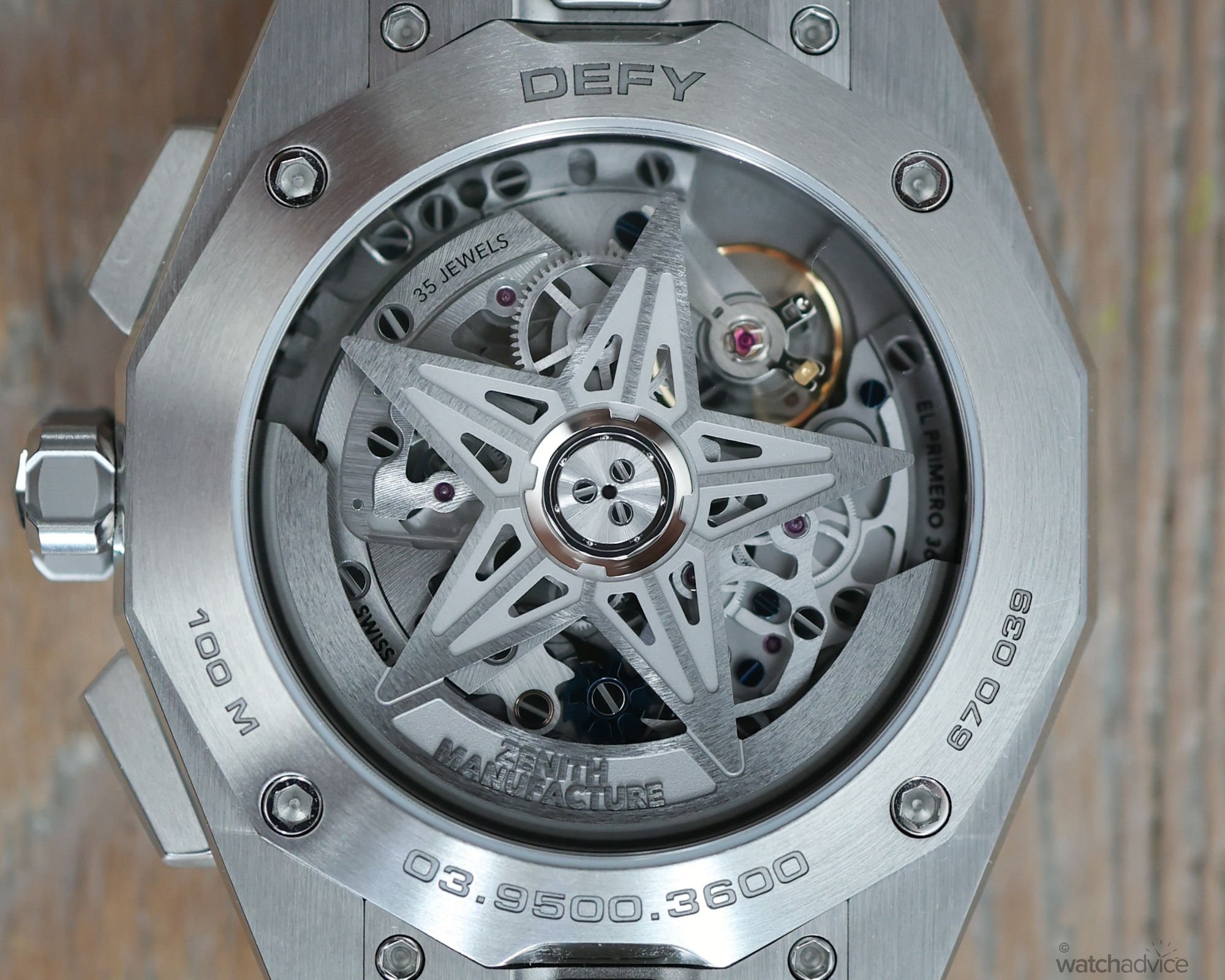
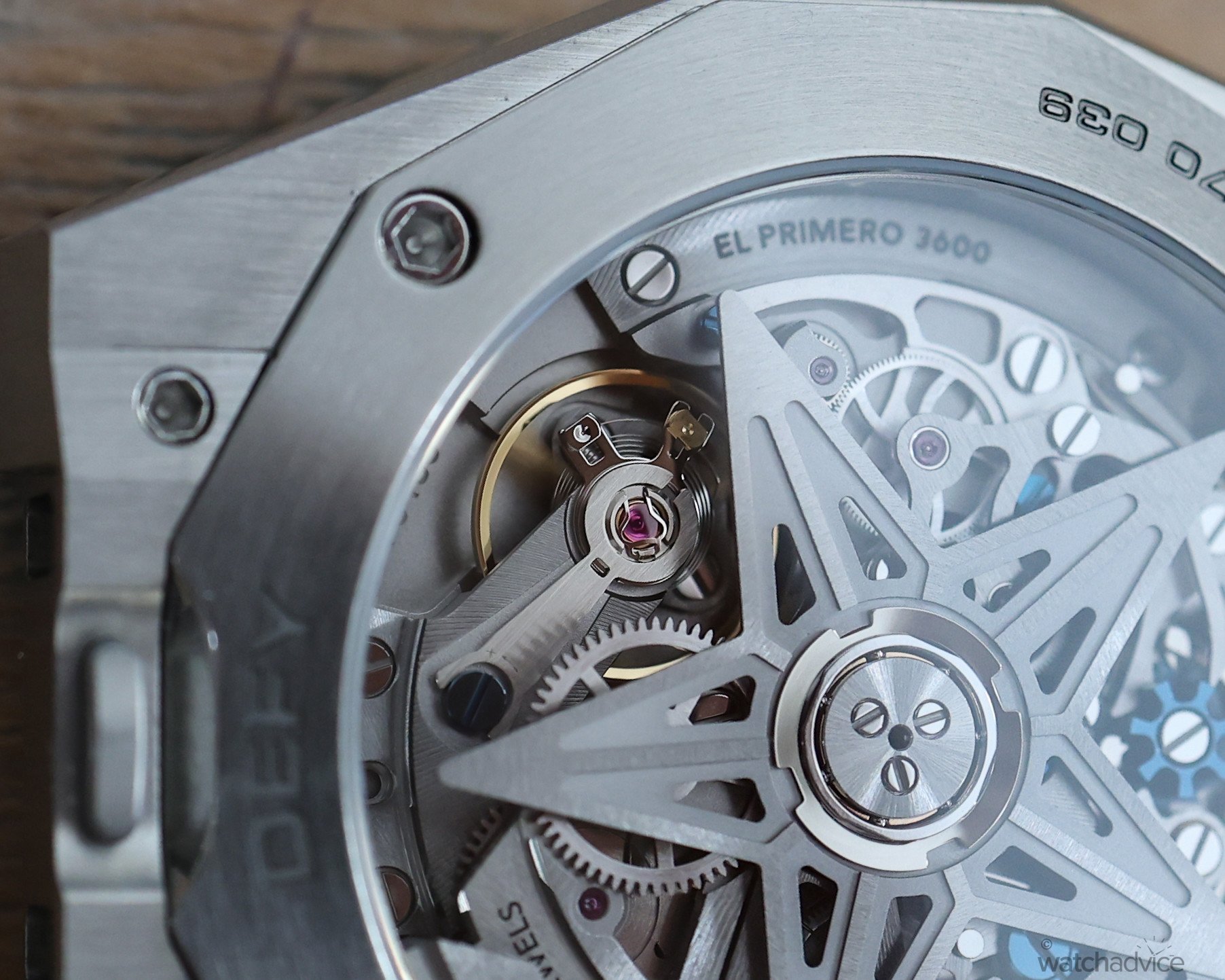
The pushers are easy to operate due to their angled design with the case, which I’ve mentioned earlier in the article, and have a good balance of firmness and resistance when pressing them in to start, stop and reset. The screw-in crown gives the Defy Skyline Chronograph an ensured 100m water resistance, and even with the chronograph pushers, is easy to access and unscrew to change the time. Some crowns can be a little tricky, but I’ve not found this with the Defy Skyline models.
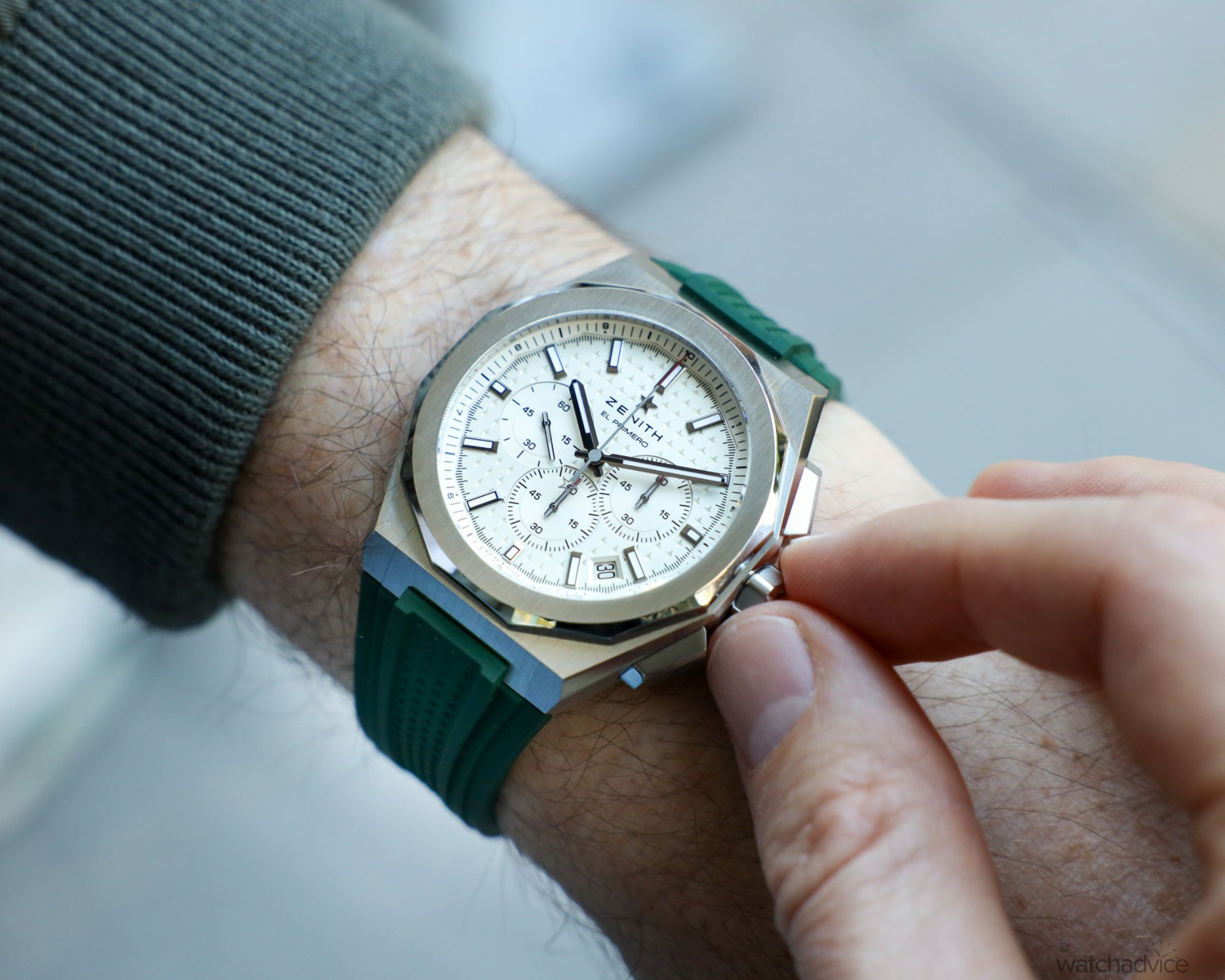
With the Defy Skyline Chronograph, you get a decent 60 hours of power reserve when the chronograph isn’t running which admittedly isn’t massive by today’s standards with many brands now opting for 72 hours as standard, but it is much more palatable than a 42-hour power reserve, which I feel just doesn’t cut it nowadays. The Defy Skyline Chronograph kept good time when I set it to a reference time and tested it over a couple of days – only losing about -1 second per day. While this is indicative of its timekeeping whilst on the wrist, a much longer test being on and off would perhaps yield different results. I can say that my Defy Skyline seems to stay within about minus 1-3 seconds per day. So this is good given it’s not COSC or METAS certified. The high beat rate of 5Hz helps with this accuracy here.
Final Thoughts
When you spend a week with a watch on your wrist, you get a very good sense of how it wears, how it connects with you and the potential (should you be in the market for a watch) of buying it. In this instance, having already owned the Defy Skyline in blue, I had a little head start here. But every watch is different and you don’t know how you’ll connect with a piece until you have some time with it. As an example, I wasn’t a fan of the white dial on the time only which I outlined briefly in the opening paragraphs. It didn’t resonate with me at all. But the Defy Skyline Chronograph? Different story. The addition of the subdials, no 1/10th second hand spinning continuously at 9 o’clock and the look of the watch with the chronograph pushers paired with the green strap kind of ticked a lot of boxes for me.
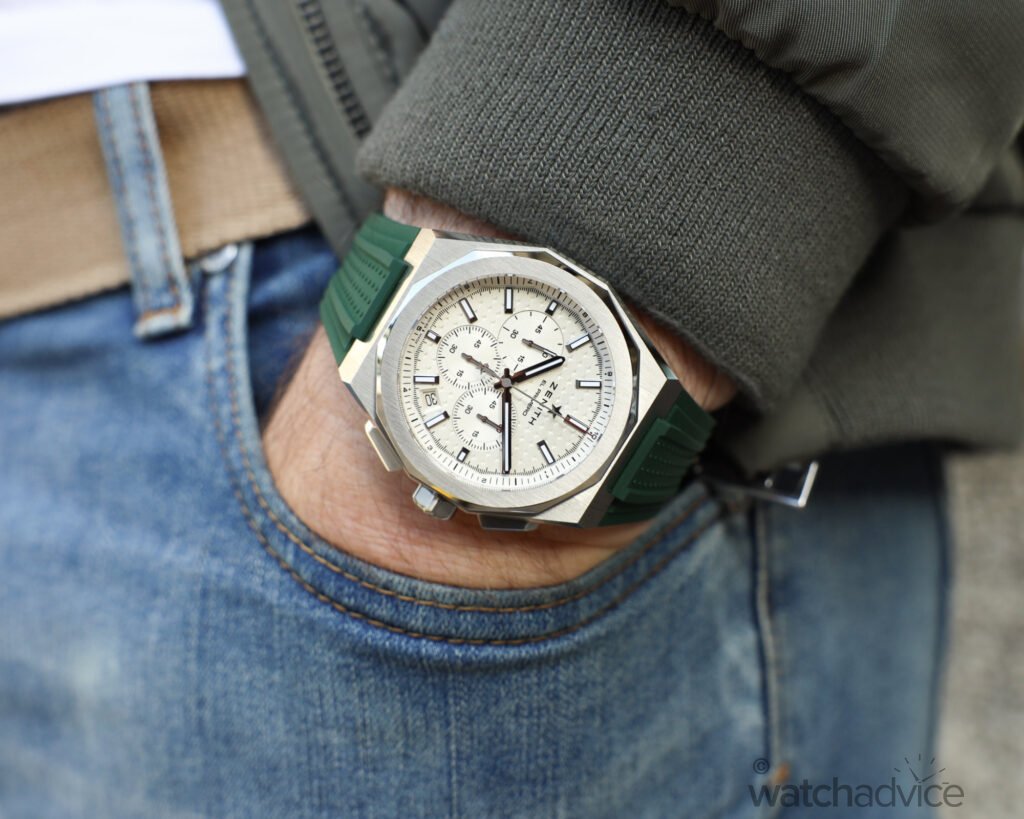
It is not a dress watch, so don’t expect to be wearing this with a suit and tie – well you could but that’s not the natural element for the Defy Skyline Chronograph. It is refined in an industrial kind of way, rugged and angular with a few vintage design cues blended with modern lines. And if you think this is just another piece wanting to be a Royal Oak, it’s not. This is pure Zenith, through and through. Yes, there are some similarities like the case, but don’t forget, Zenith had these styles of cases before Gerald Genta created the Royal Oak. The bezel shape is vaguely reminiscent, but this is 12-sided, not 8 and there are also no screws on the bezel either. No crown protector and no screw-in pushers. Not to mention the quick release system on this which you’re also not getting with the AP.
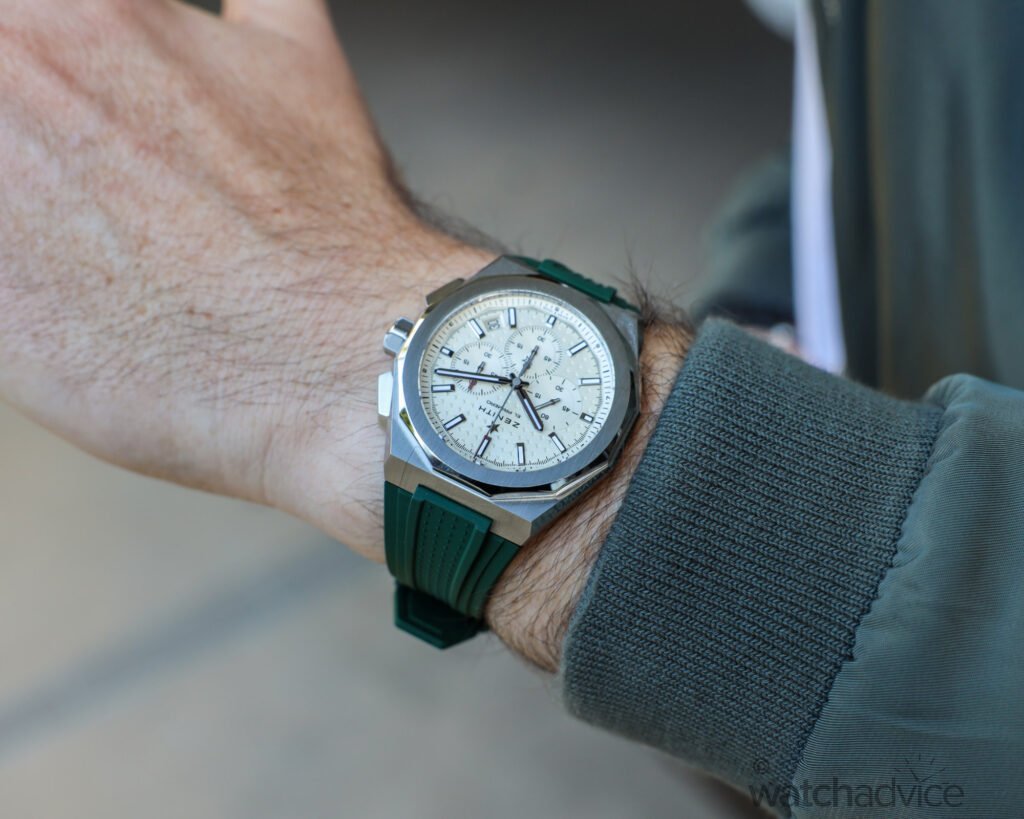
At A$20,700, you’re also less than half the price of other integrated watches, but the El Primero has heritage as Zenith has used the movement in some way, shape or form over the years in iconic pieces, not to mention supplying to brands like Rolex for their Daytona. And this is what you’re paying for – the great design cues, the heritage of the El Primero (being more efficient and accurate) and the fact that you get both the steel bracelet and rubber strap with clasp as standard to swap in out to change the look up as you wish.
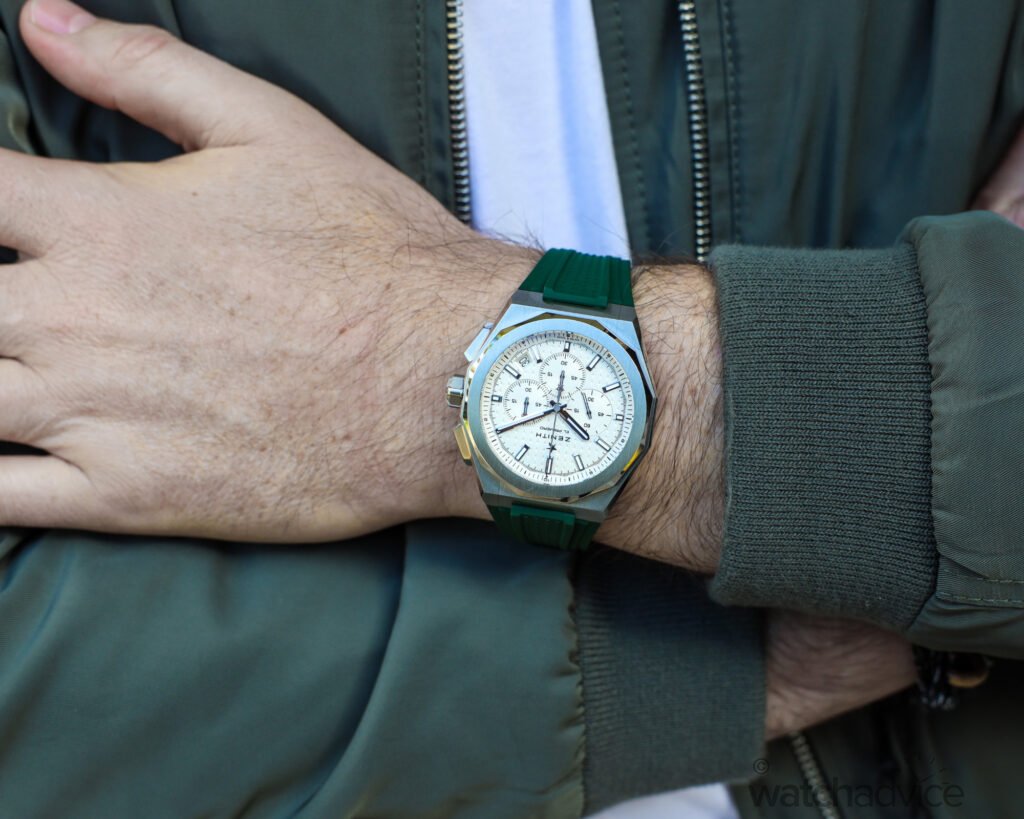
References:
- Silver/white (Fedatured) – 03.9500.3600/01.I001
- Blue – 03.9500.3600/51.I001
- Black – 03.9500.3600/21.I00
Specification:
- Case: 42mm, 47.7mm lug-to-lug and 12.7mm thick
- Case Material: Brushed and Polished Steel
- Case back: Steel screw-down with sapphire display back
- Dial: Sunray brushed, star patterned silver/white dial (as featured) or blue or black with sub-dials
- Crystal: Sapphire crystal with anti-reflective coating
- Water resistance: 100 Metres (10BAR) with Screw-Down Crown
- Movement: El Primero 3600 high-frequency automatic movement with 1/10th second chronograph function
- Power reserve: 60 Hours
- Strap/Bracelet: Integrated steel bracelet with interchangeable matching blue or black rubber, green with the white/silver dial with quick change system
Australian Recommended Retail Price: AU$20,700
Availability: Available shortly through all Zenith Boutiques, authorised retailers or online at Zenith-watches.com
This article was written as part of a commercial partnership with Zenith. Watch Advice has commercial partners that work with us, however, we will never alter our editorial opinion on these pieces, a fact that is clearly communicated to the brands when entering into a commercial arrangement. At Watch Advice, we categorically do not sell outcomes or our editorial integrity. We will never say a watch is good when it’s not.
Image Gallery

